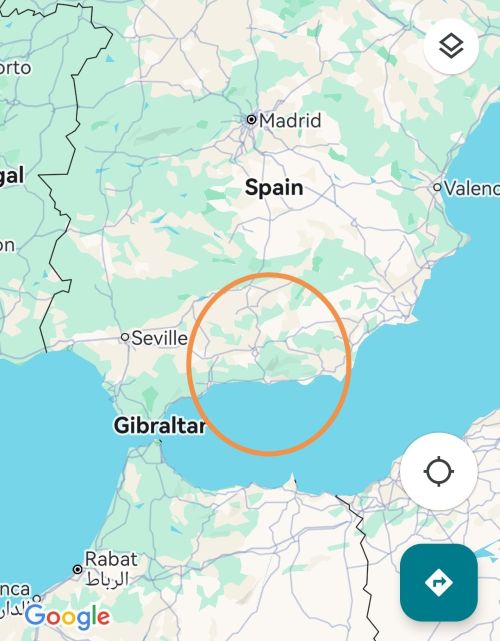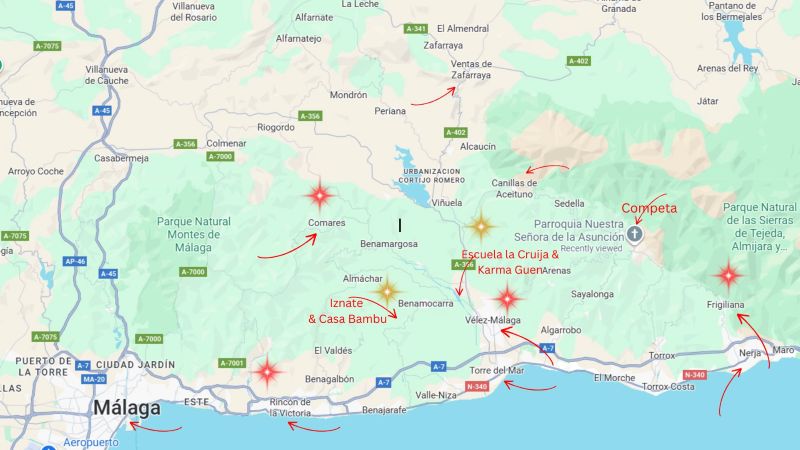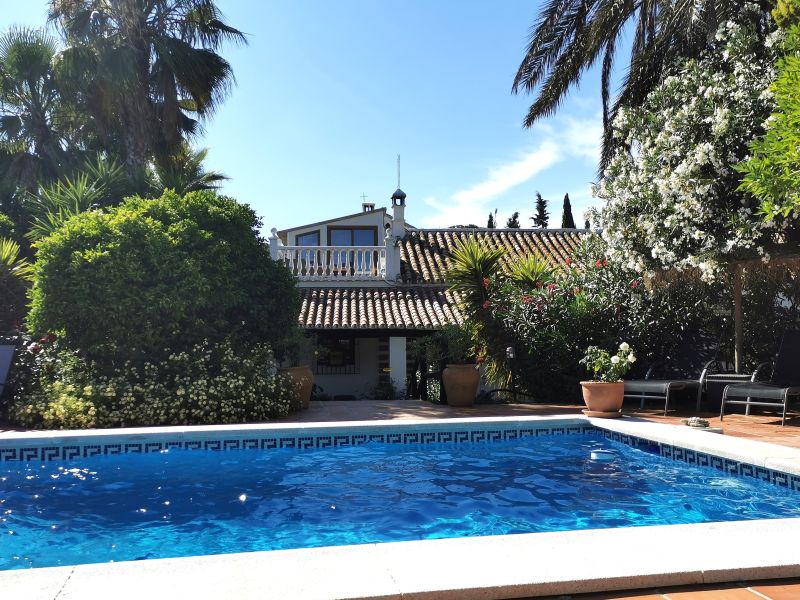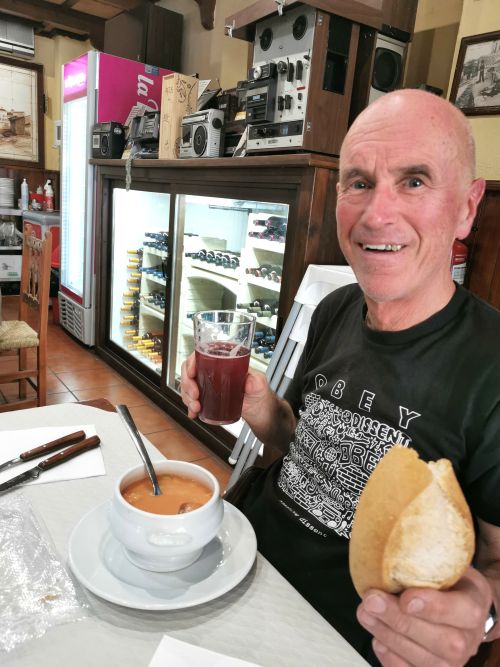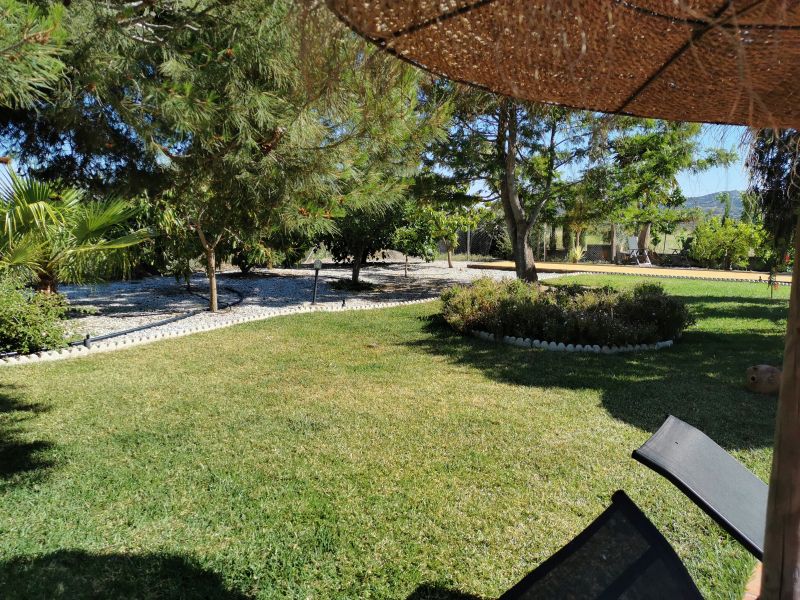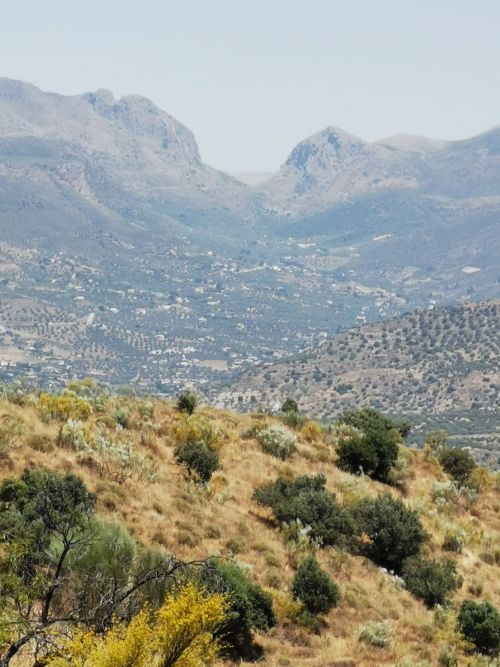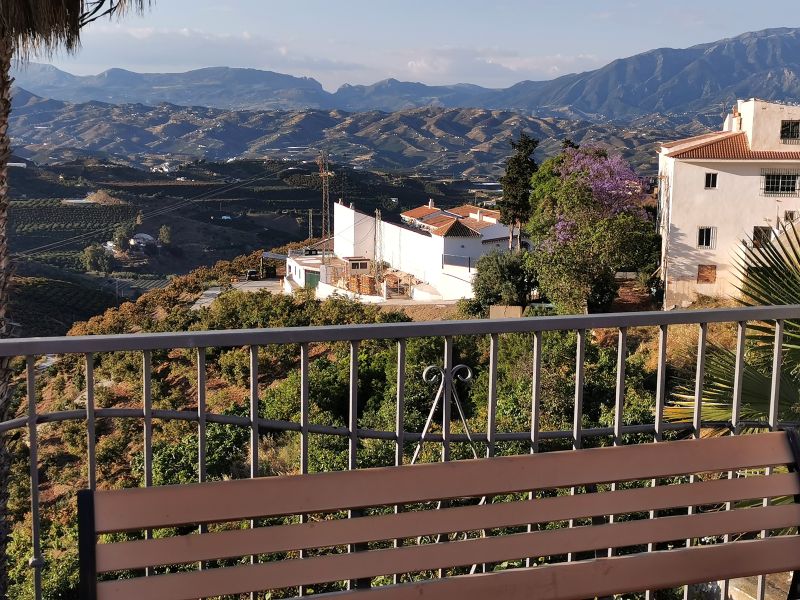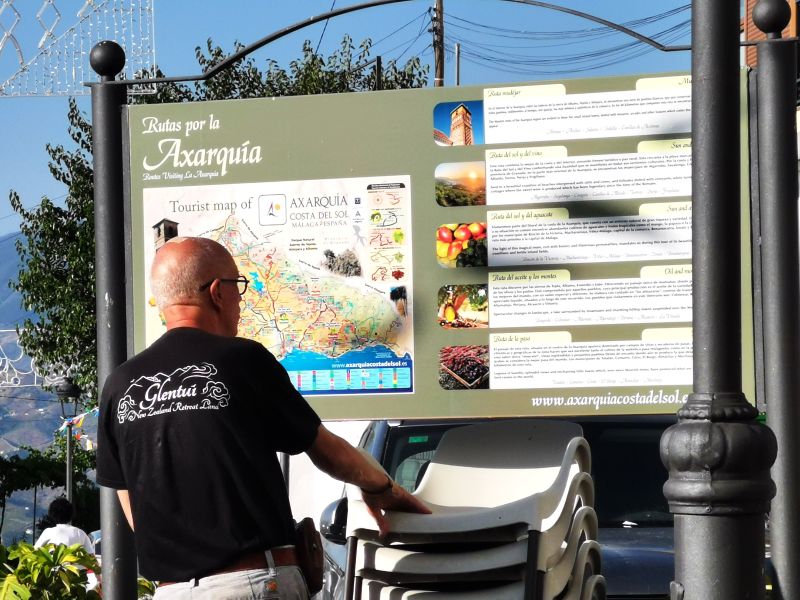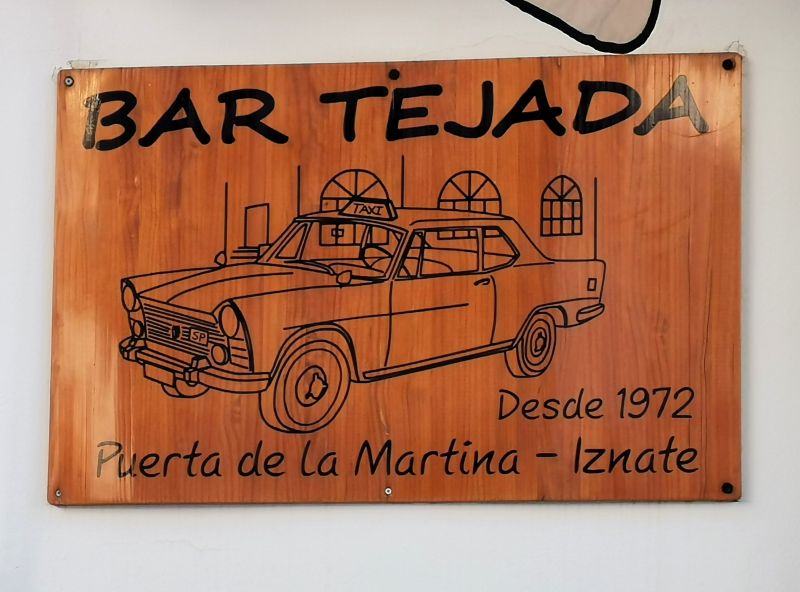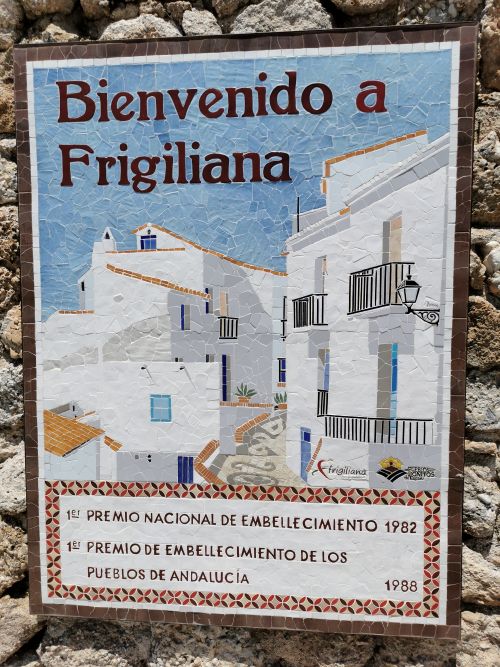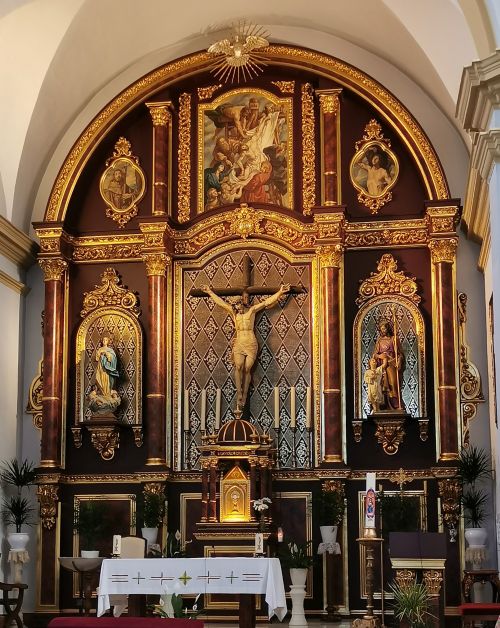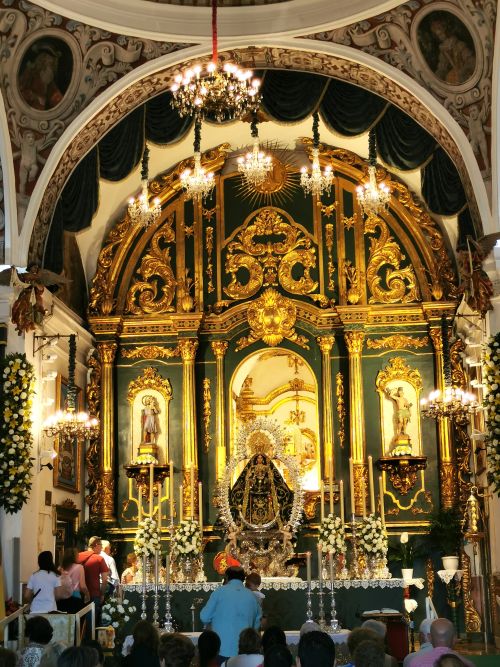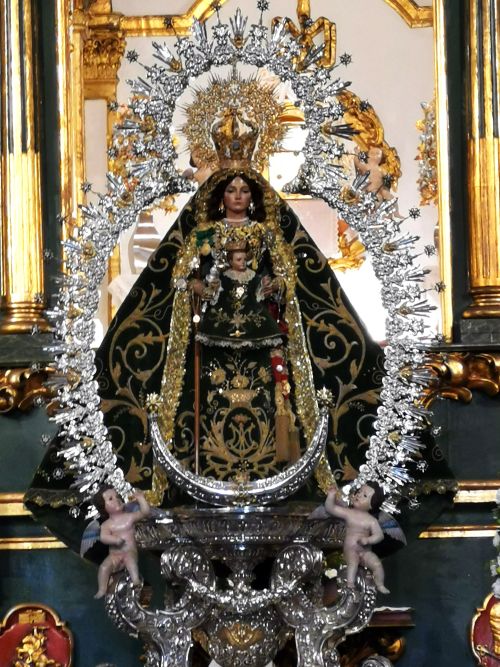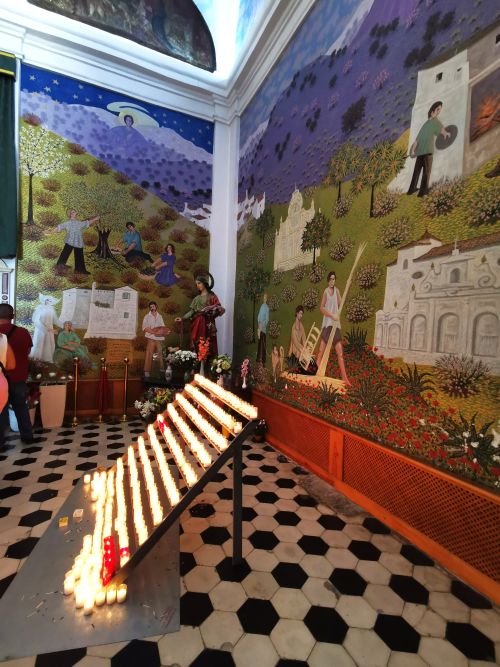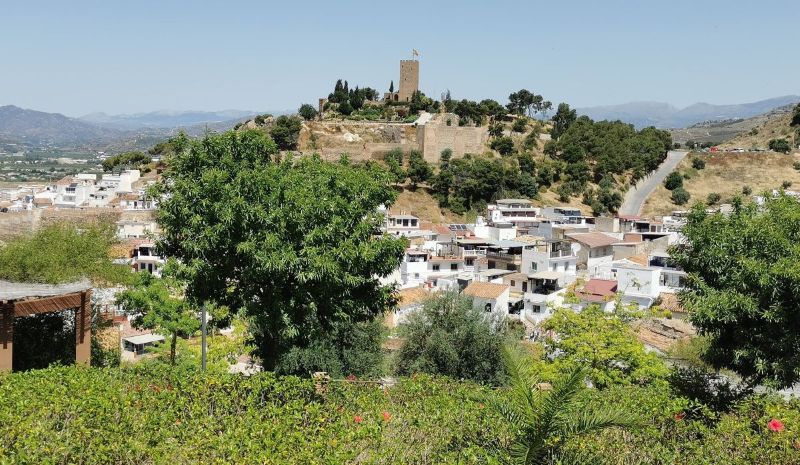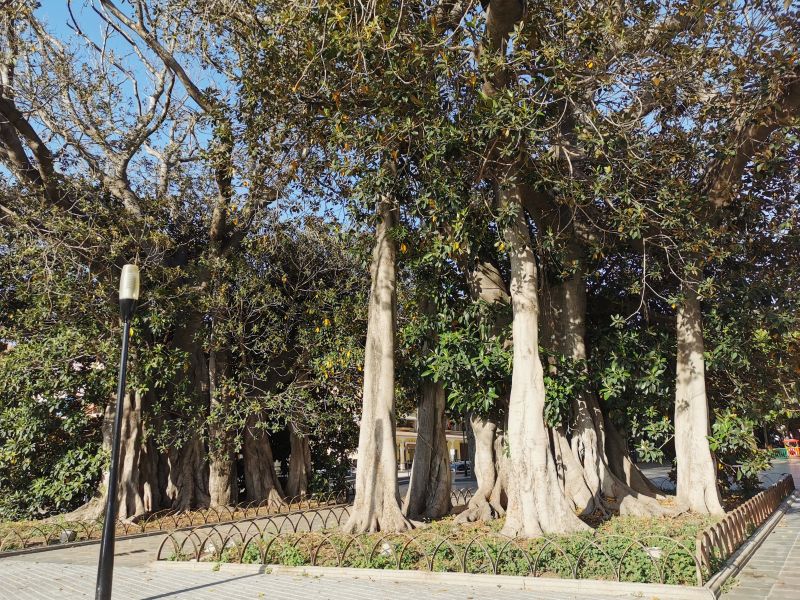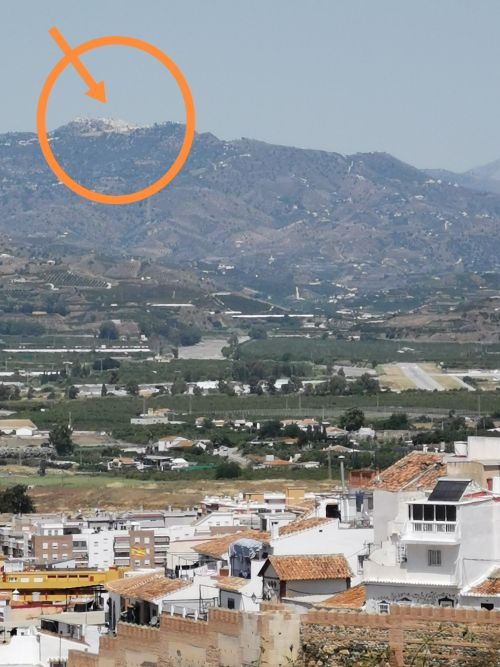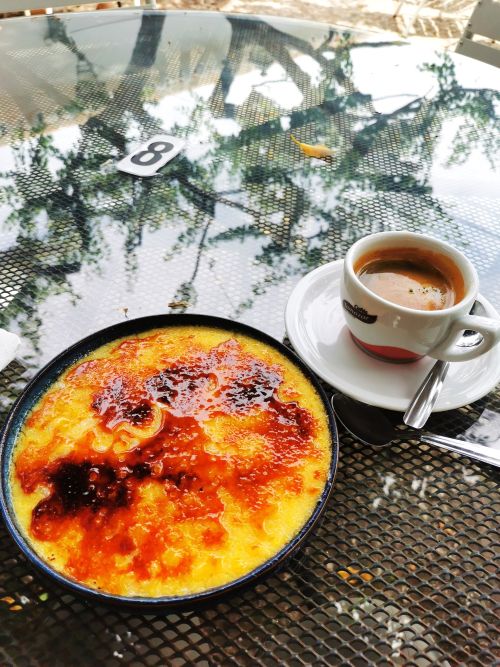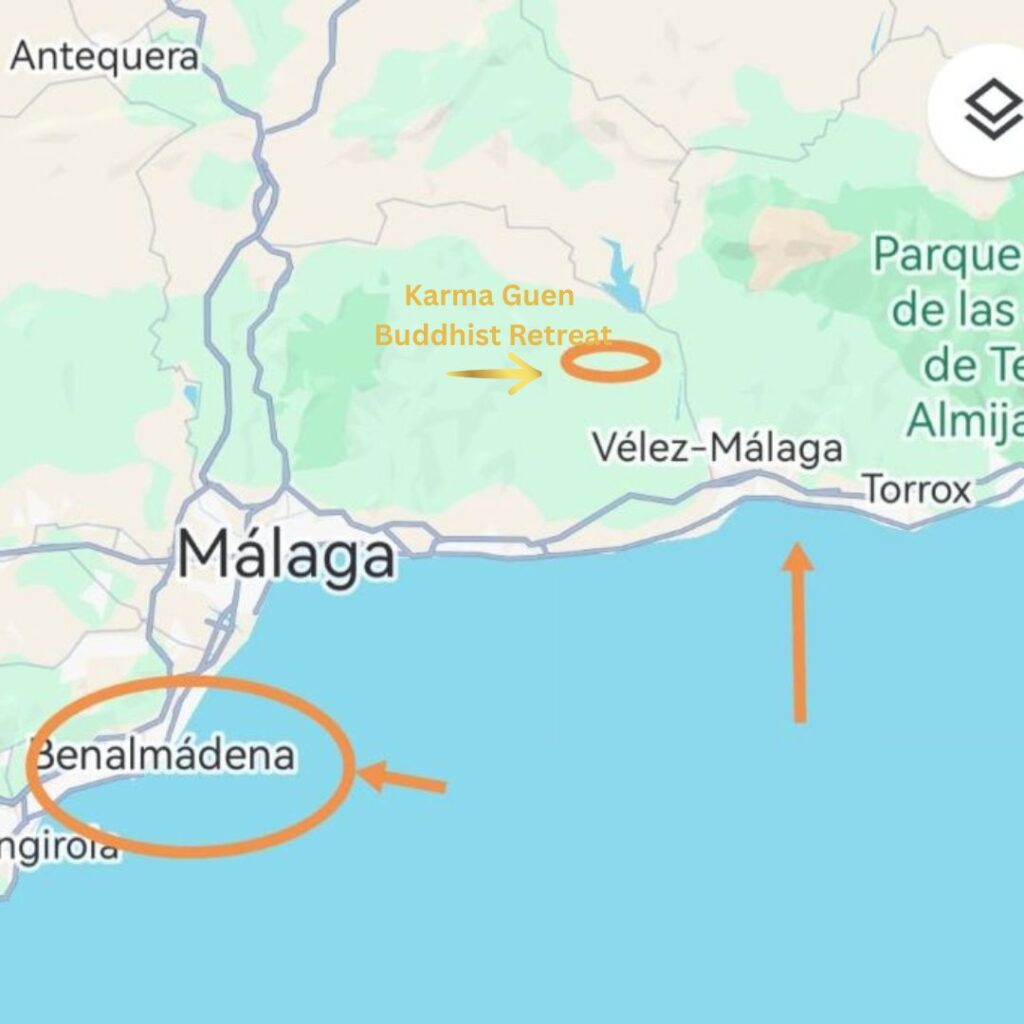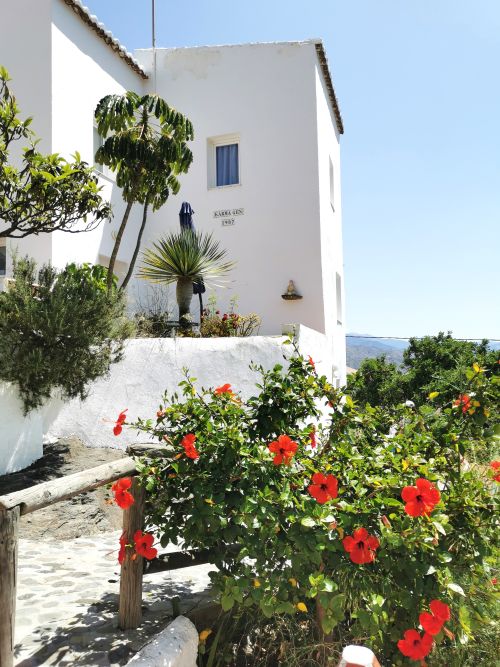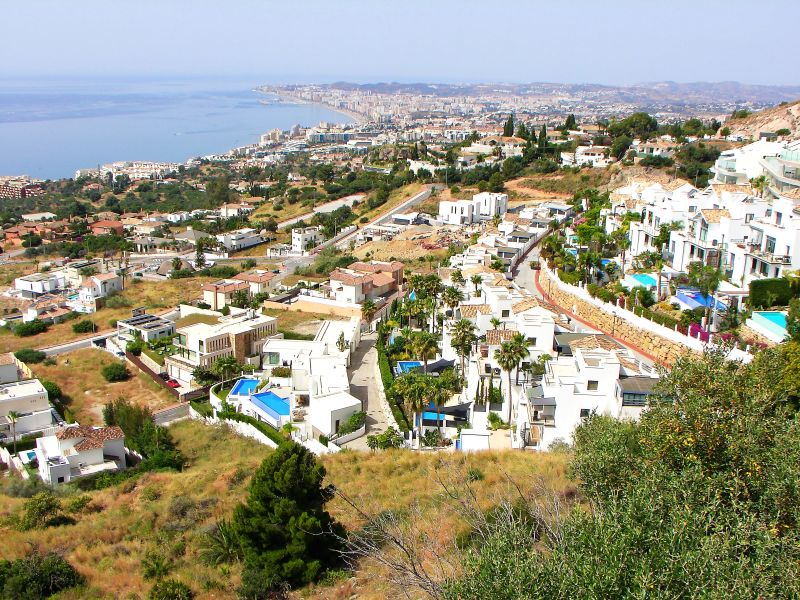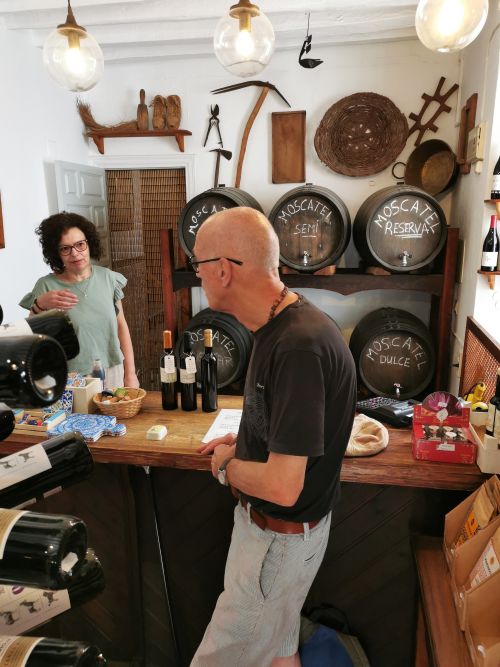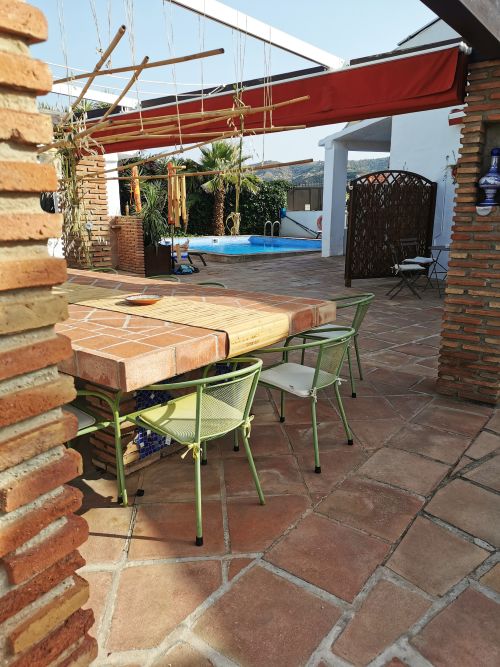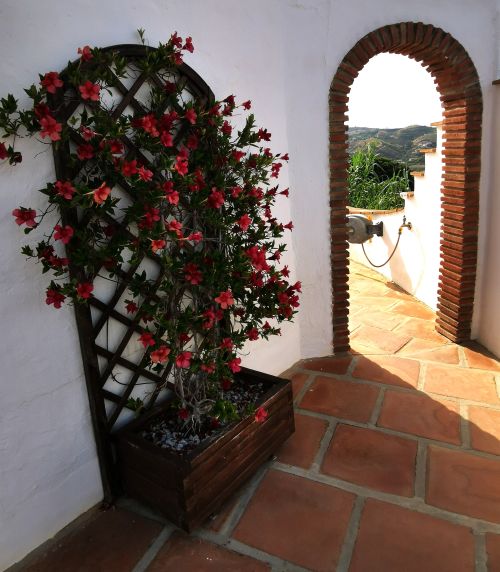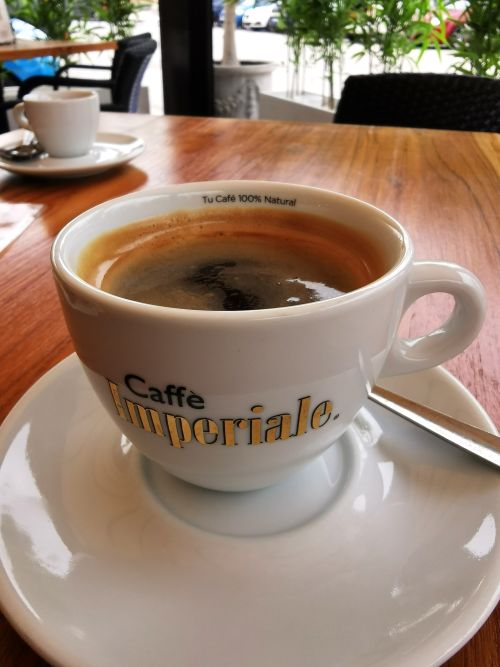Once again I wish to acknowledge and thank my wonderful friend Shoba Nayar who edits my writing, and who’s careful eye and amazing suggestions helps bring alive stories from our travels!
Where in the world are we? – Southern Spain
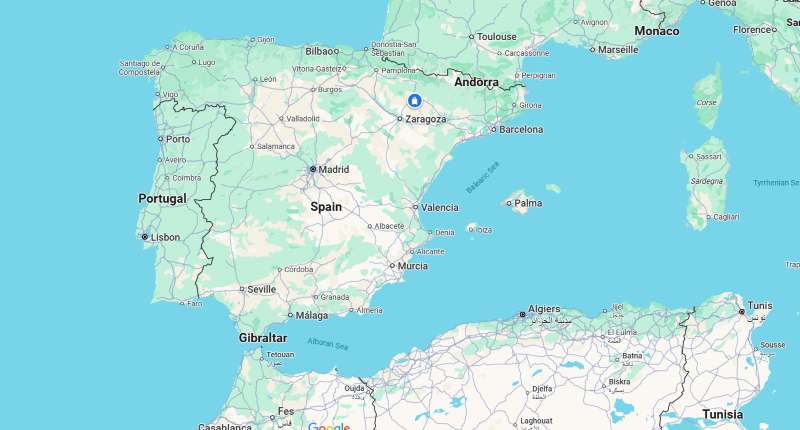
Arriving in Málaga, after long but comfortable flights from New Zealand, Singapore, and Frankfurt, we made our way to the baggage claim and car hire area amidst the busy airport.
Remember to open up the groups of photos to see them fully!

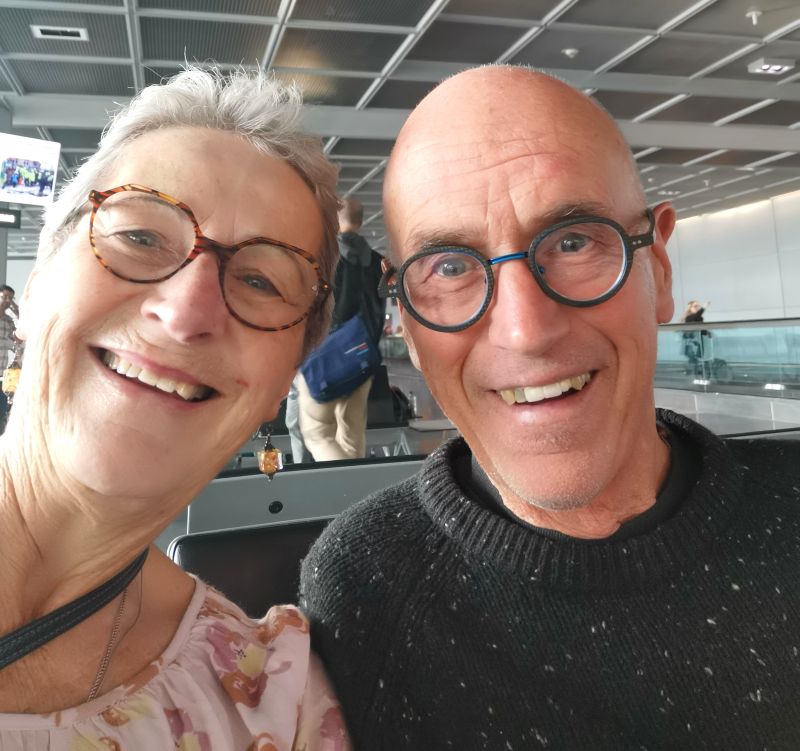
Arriving in Andalucía
We drove the familiar highways from the airport, skirting high above Málaga and the Costa del Sol, passing Rincón de la Victoria before turning off towards Vélez-Málaga and away from the built-up coast of the Torre del Mar. We drove the short distance to find our accommodation—Escuela La Crujia—at the bottom of a hill that leads to ‘Karma Guen’, our Diamond Way Buddhist Retreat.
Escuela La Crujia
https://www.escuelalacrujia.com
Stopping for a delicious lunch at a roadside restaurant and breathing in the atmosphere we so loved, were delighted to be back once more in the familiar Axarquía region of Andalusia. We had arrived a few days prior to the start of the retreat at Karma Guen, so we checked into Escuela and relaxed, starting at the swimming pool, happy to be ‘home’ in the warmth of the south of Spain while New Zealand dove into late autumn and winter loomed on the calendar.
Koen, Liesbeth, their daughters and dogs, originally from Belgium, were our wonderful hosts for our 11 day stay. This lovely historic, rustic, converted school house, now offers accommodation to small numbers of guests over three beautiful private suites with attached bathrooms and terraces.
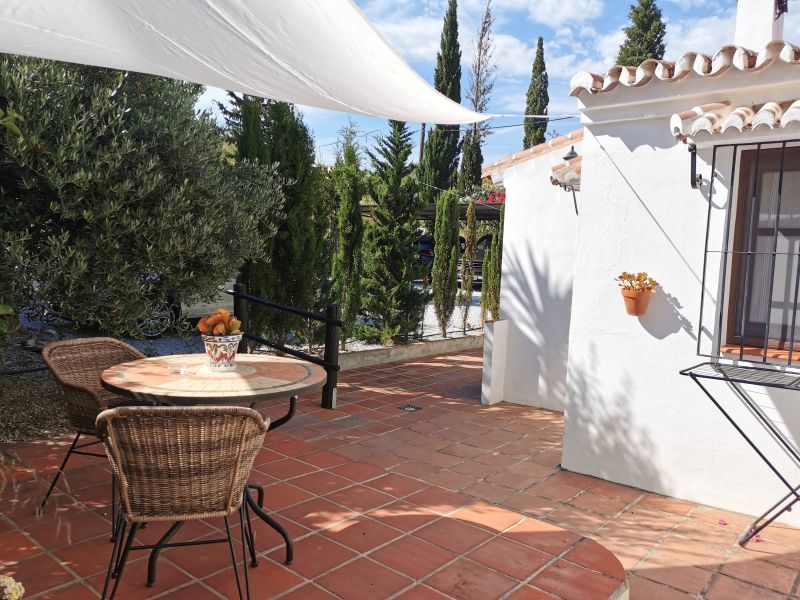

The Terrace at Escuela and Manfred enjoying some local wine on the terrace
Enjoying the lovely Andalucian sun
A short walk within the gardens and BBQ areas leads to the pool where one can relax on the loungers or go for a swim. The website tells how the school was built in the 1940s to provide education for the children of the hamlet of ‘La Crujía’ but closed in 1995. The building has been lovingly and fully restored and extended to become accommodation for holidaymakers.
Remember to open up the groups of photos to see them fully!
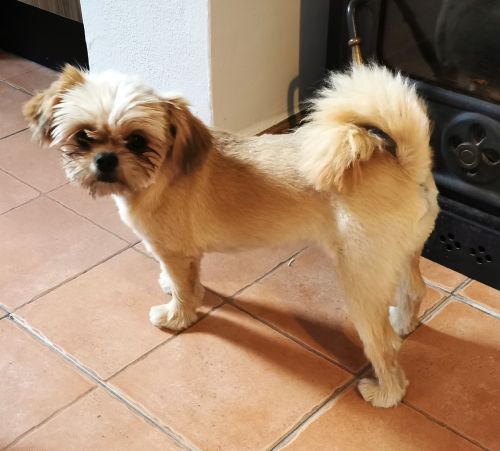
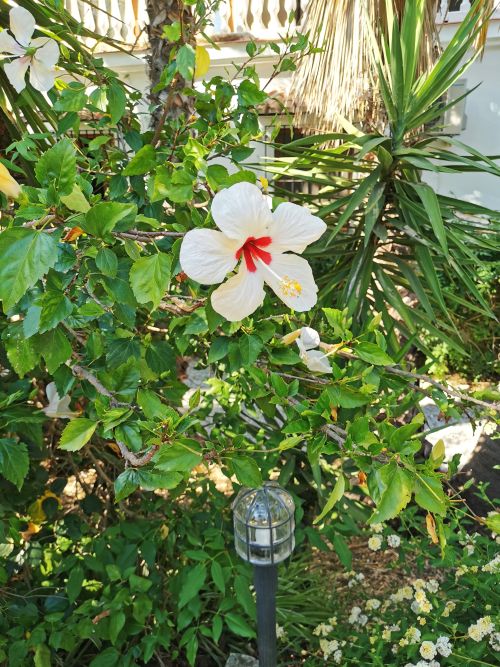
Lets Look inside!
Formerly the schoolroom and hall, the breakfast and guest living room areas house a large fireplace, comfy large sofas, an abundance of reading material in the form of books and pamphlets in English and Spanish, and games and kids’ toys. It was a delight to have our tasty breakfasts in the schoolroom where you could be forgiven for sneaking that extra piece of jamon and bread, fresh squeezed orange juice, coffee or toast, and homemade jams before the ‘teacher’ caught you red-handed. My imagination was running away with me, but I enjoyed the game I played in my schoolgirl’s head as I licked the yoghurt from my spoon!


The schoolroom now a breakfast and relaxation room in Escuela la Crujia
Taberna ‘Cruza la Calle’
Koen and Lisebeth were a wealth of information when asked about places to eat in Vélez- Málaga, and this led to a lifelong love of the Taberna ‘Cruza la Calle’, which translates to ‘cross the street’; and yes, they have a ‘sister’ restaurant right across the street ‘Restaurante la Gamba Dorada’. The food was great and the staff were amazing—we returned on quite a few occasions and got to know them. Manfred enjoyed chatting with them in Spanish and we formed lovely relationships as they took a special interest in us.
Remember to open up the groups of photos to see them fully!

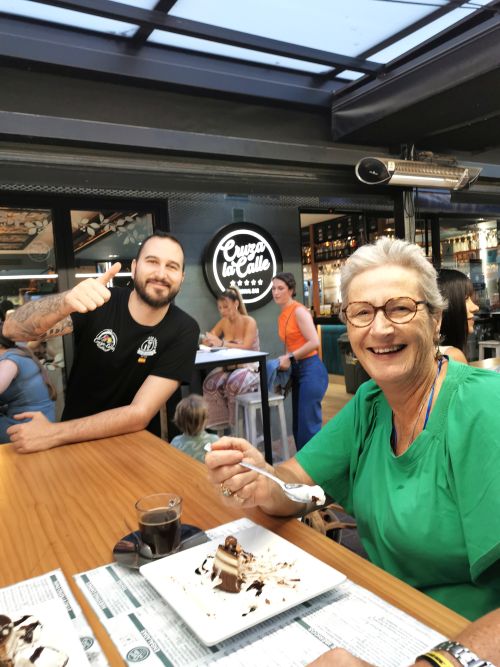


Around the region of Axarquia, Andalucía
Sitting among lemon, mandarin and olive groves, the valley is lush and tropical. I have also been in this area when there were fields of ripe artichokes, purple-topped thistle-like flowers, and bright yellow sunflowers. The guest house rests away from the coast but not too far from restaurants, bars, and city life in the villages and Vélez-Málaga. In the other direction, you can drive to many amazing white villages that dot the surrounding hills and valleys of this stunning countryside, among a mass of vegetable farms, fruit, almond and olive groves, waterways and immense beauty. The interior of Andalusia lies on roads that take you to Granada, Cordoba, and Seville; with coastal highways towards Marbella, Gibraltar, and Cadiz to the west; Nerja and Almeria to the East; and on up the Mediterranean coast towards the famous seaside towns of Alicante, Valencia, and on towards Barcelona.
Enjoying the ‘fruits’ of Spain – Sangria

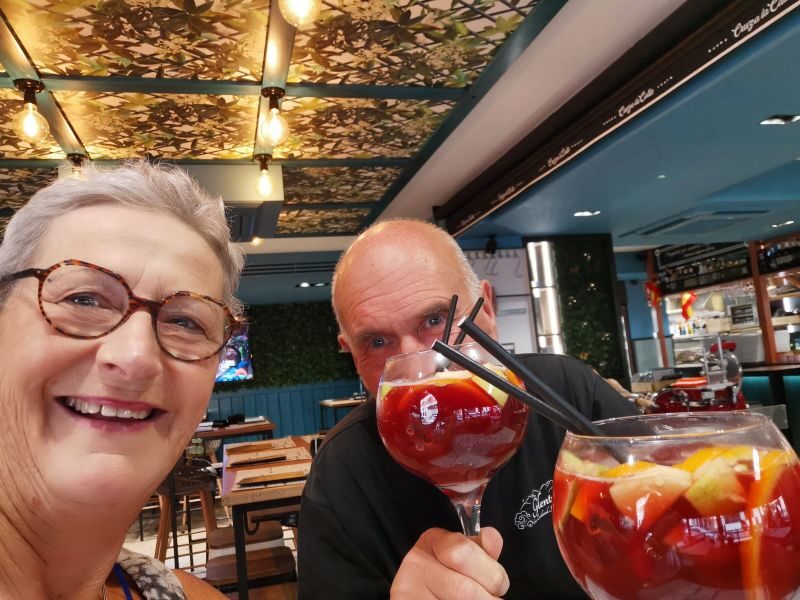
Manfred discussing the menu with one of the staff at Cruza la Calle who had made the amazing Sangria!
The wider region of Andalusia, stretching across Southern Spain, comprises hills, rivers, and farmland, and rests on the southern coast of Spain. It was ruled by the Moors from the 15th to the 18th century, but was also under the rule of the Romans and others in its colourful and rich, sometimes brutal, history of civil war and overthrow. The region, now free of invasion and rule by tyrants, has been left a legacy of landmark architecture such as the Alcázar castle in Seville, the Mezquita Mosque, Alcázar de los Reyes Cristianos and Jardines (gardens) in Córdoba, and Granada’s Alhambra palace. Past rulers and invaders integrated a rich culture of agriculture, food, dance and wine. One day as we were driving along a local road, the traffic slowed to a stop. Wondering why, as we moved slowly forward, we soon saw a small turtle crossing the road. The traffic was careful not to cause it harm but as there was nowhere to stop and help it across the road we sent it good wishes as we moved on our journey!
The Lions Gate of Ventas de Zafarraya
There is an iconic gap in the Sierra Nevada Mountains called ‘The Lions Gate of Ventas de Zafarraya’ or ‘El Boquete de Zafarraya’—a pass between the provinces of Malaga and Granada. It is easily seen in several of our photos, forming an obvious U-shaped gap.
As well as offering spectacular views, it is a historical pathway between the provinces, facilitating travel and the passage of goods. After the Reconquista, a war between Christians and Muslims on the Iberian Peninsula, which started in the early to mid-8th century and ended in 1492, the area on both sides of the pass was contested for control of pastures and resources.
Iznate
We spread our wings wider and visited several villages in the area, some well known to us and some new. We started with a more local town, Iznate, which lies in the hills to the west of La Crujía and had a lovely meal and wine at the ‘Bar Tejada’, chatting to some women who had come up the valley from Almáchar for a birthday meal. The views were spectacular, and we watched the small planes follow the known pathway into the local airport near our accommodation as the sun went down over the town.
Remember to open up the groups of photos to see them fully!

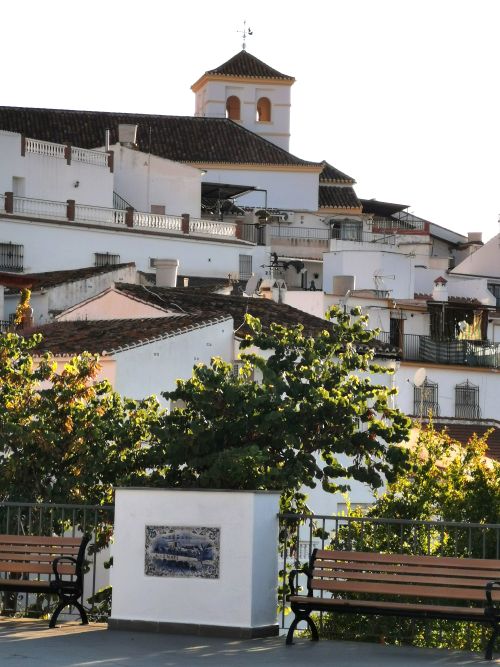
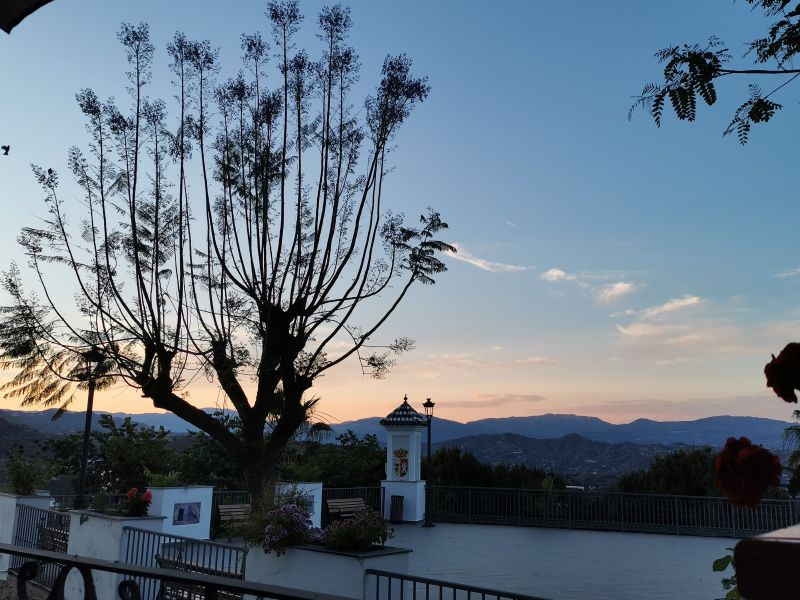
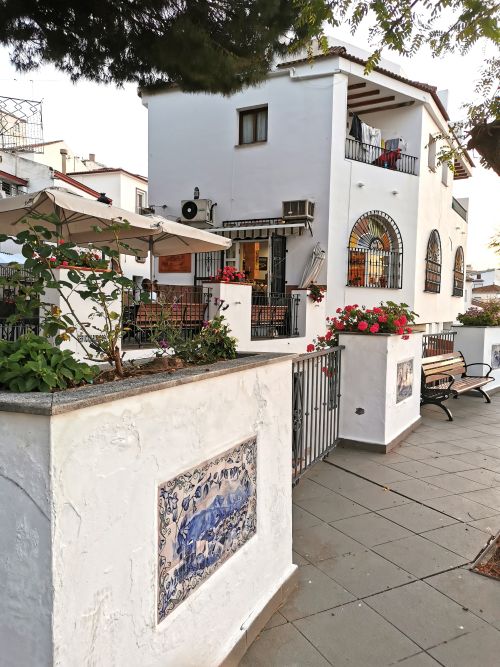
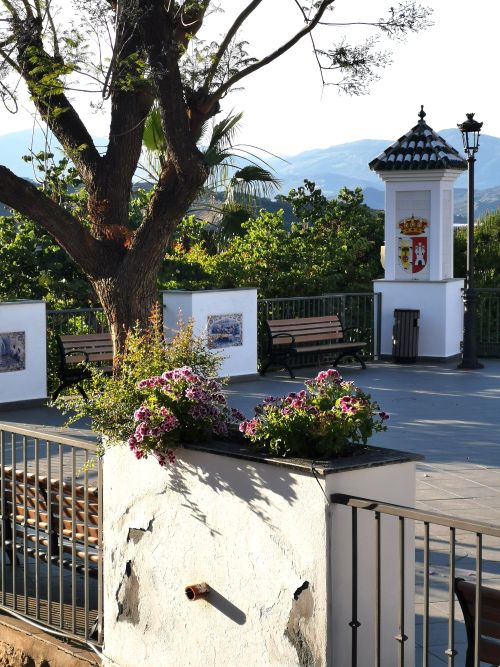

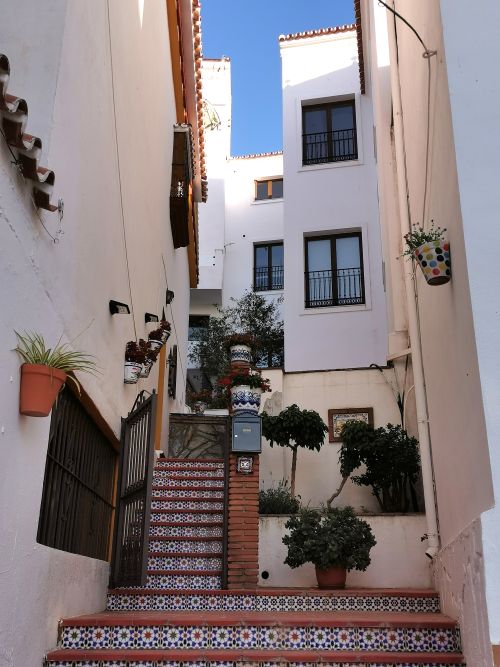

Frigiliana
Frigiliana is a village ‘close to home’ in the hills up from the seaside town of Nerja. Quaint and pretty, it offers great views, narrow pot-planted lanes of white houses with coloured doors, and ancient fountains; one dating back to 1640 and built for the cattle and local population to access water.
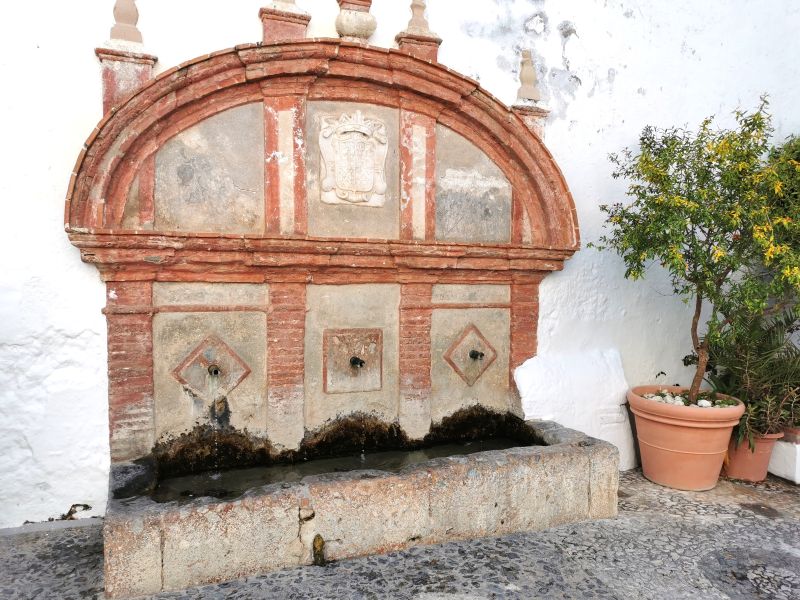
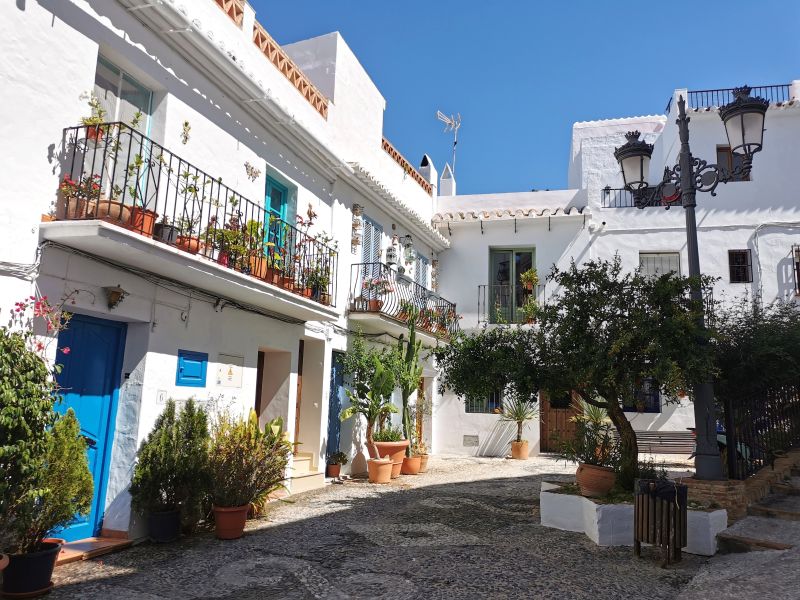
Remember to open up the groups of photos to see them fully!
There are several beautiful churches to explore; one such church, San Antonio, was built on the site of an old Mosque and completed in semi-Renaissance and Rococo style in 1676. During restoration frescoes of artistic interest were uncovered. A shining statue of the Patron of Frigiliana, The Virgen De Los Dolores (Our Lady of Sorrows), caught our eye as her image shone down from a platform adorned with flowers and lights that provided a virginal glow.
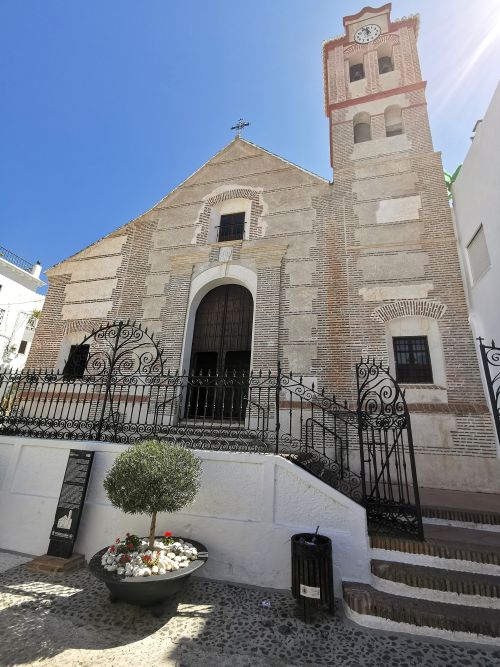
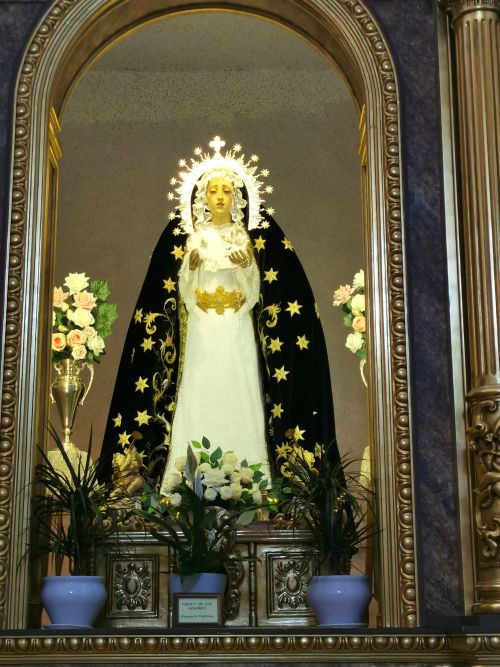
The old Moorish quarter’s narrow streets and ceramic mosaics attracted our attention as we stumbled on a restaurant after curiously exploring a doorway into a narrow lane. Staying for lunch, the terrace offered amazing views down to the coast from the balcony where an alley cat meandered up from its sunny sleeping spot near our table and sauntered with aristocratic steps to another resting spot. The food and wine were divine! They don’t have a website, but check them out on TripAdvisor.
Remember to open up the groups of photos to see them fully!


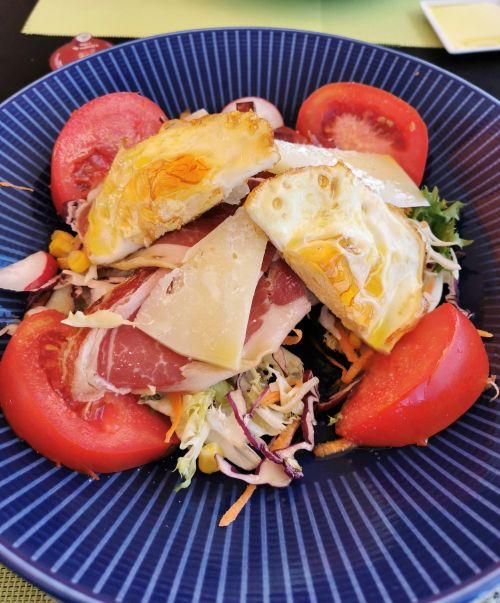
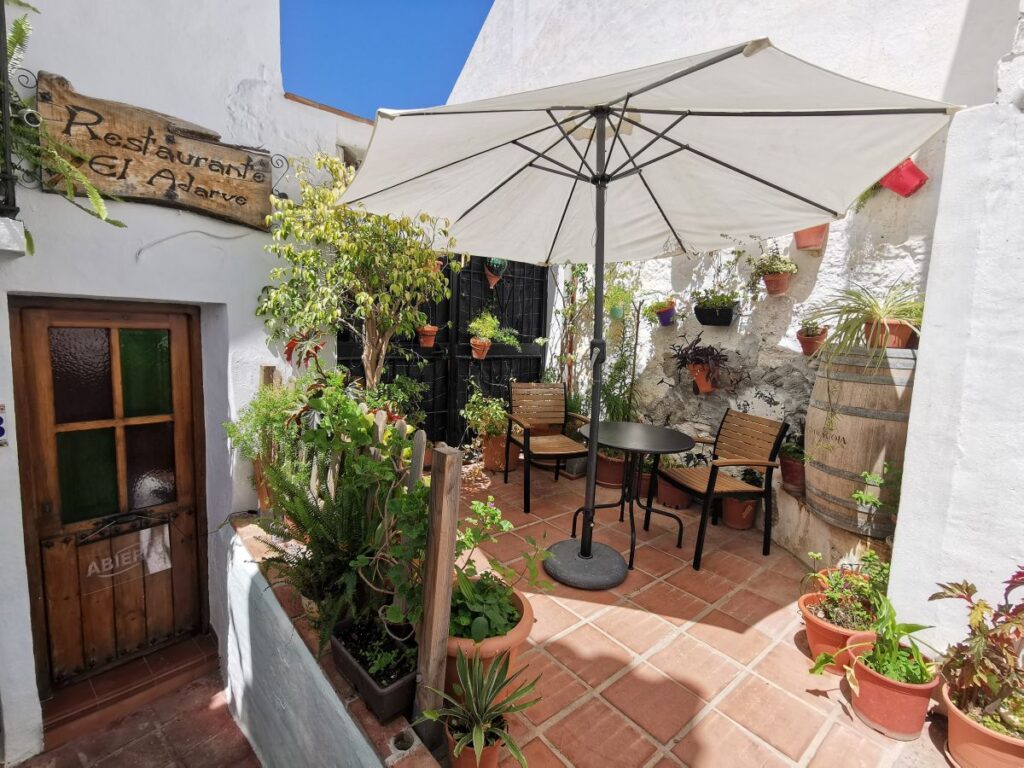
Views from the restaurant balcony
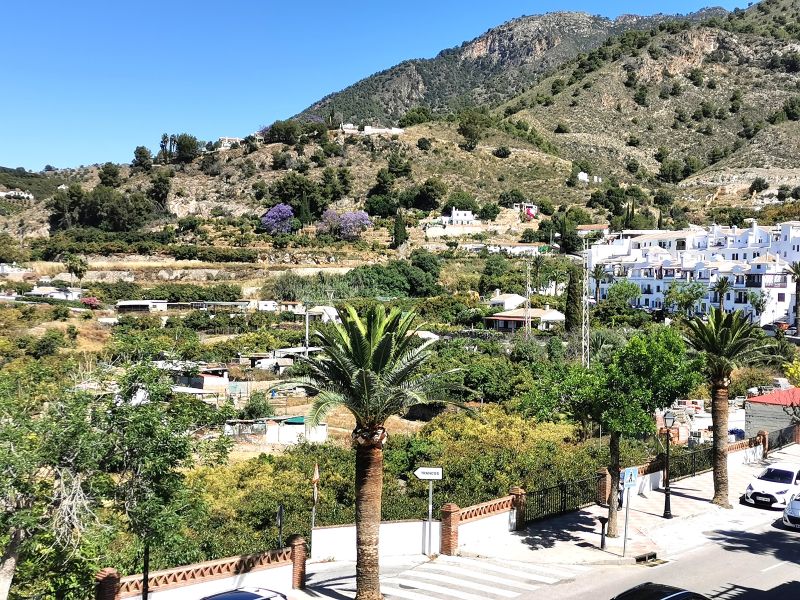



Remember to open up the groups of photos to see them fully!
Narrow lanes, cactus plants, white houses & coloured doors
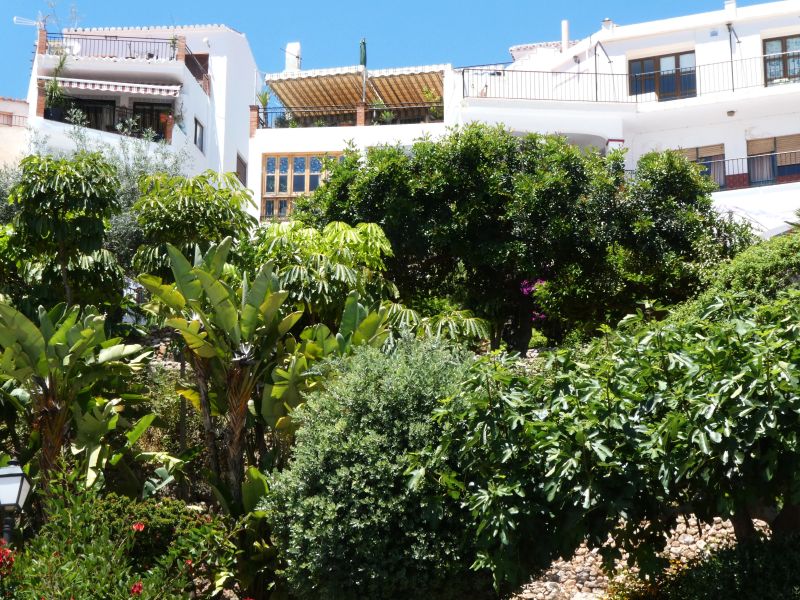
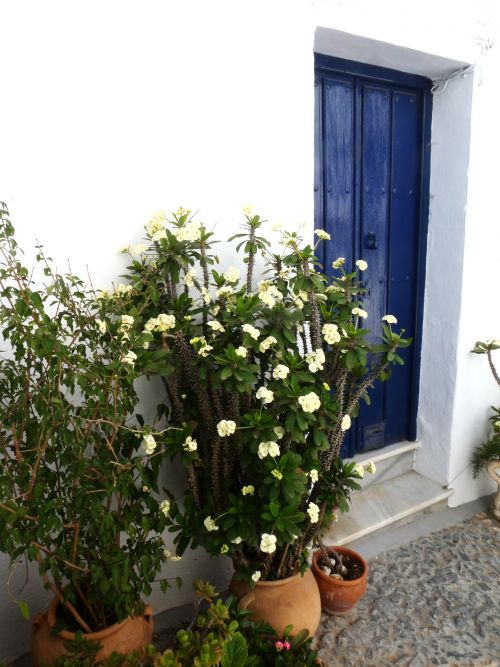

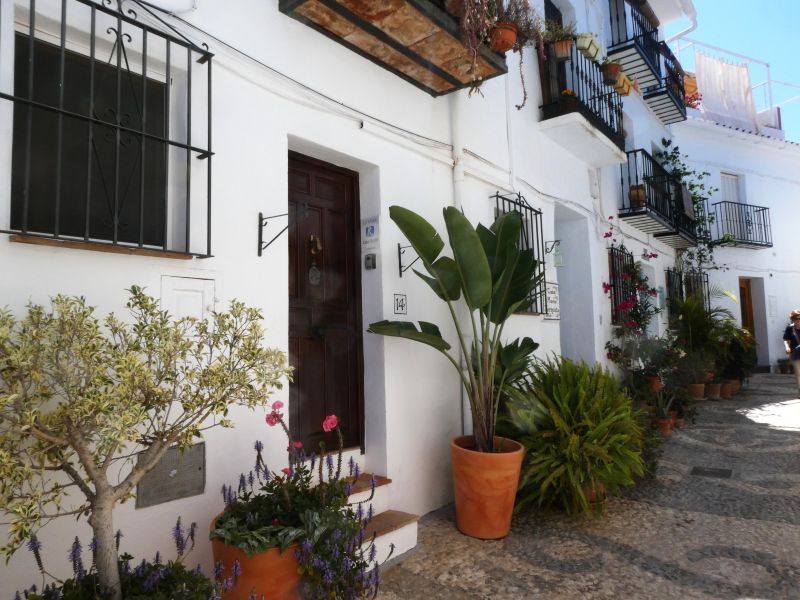
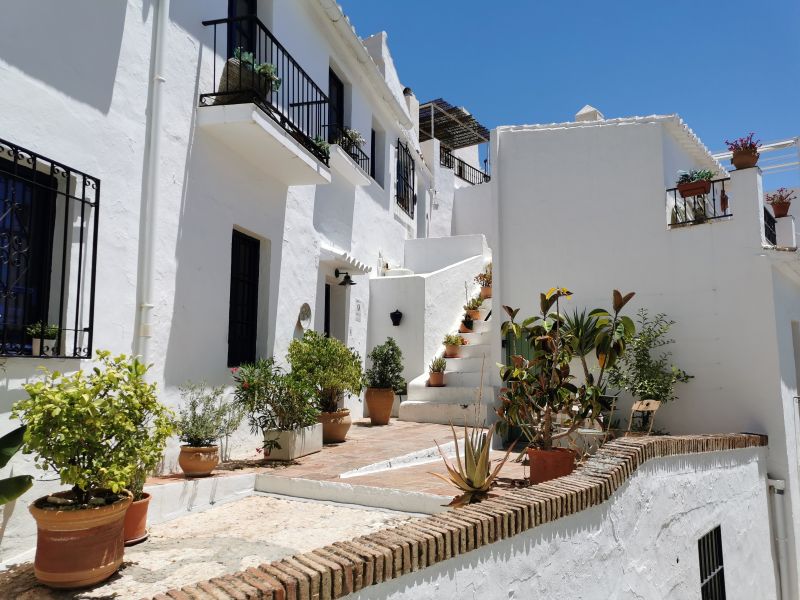
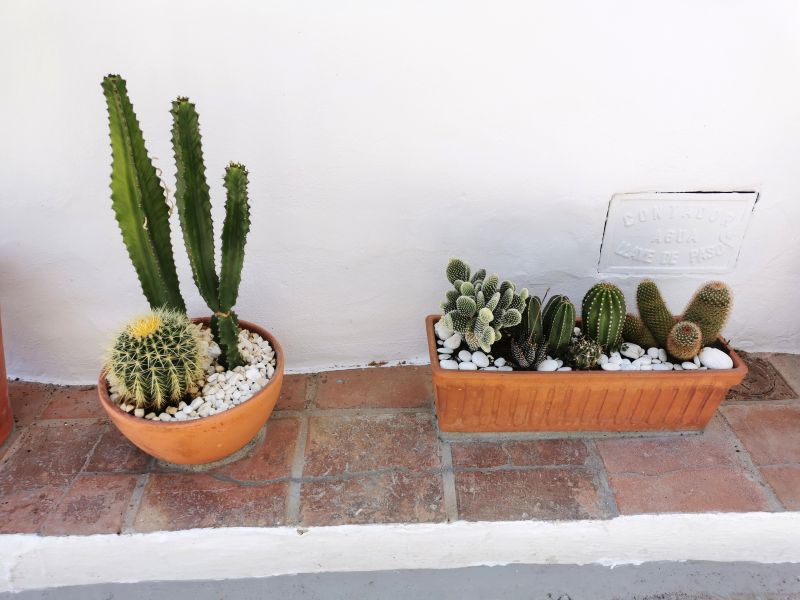
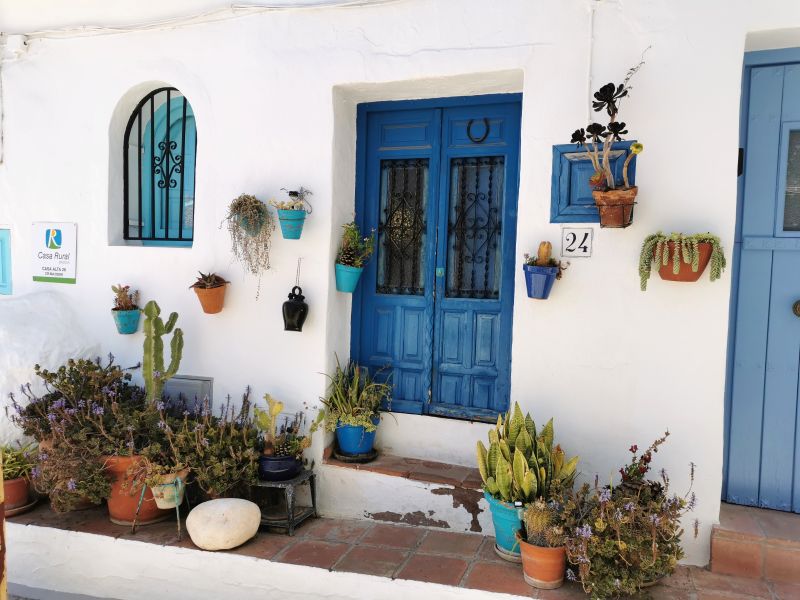
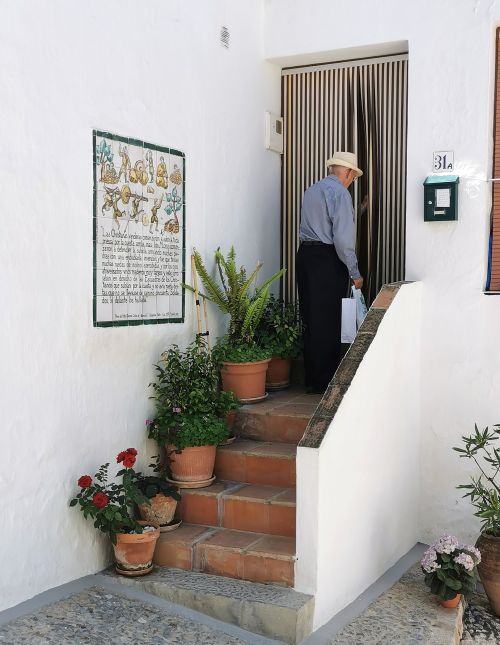
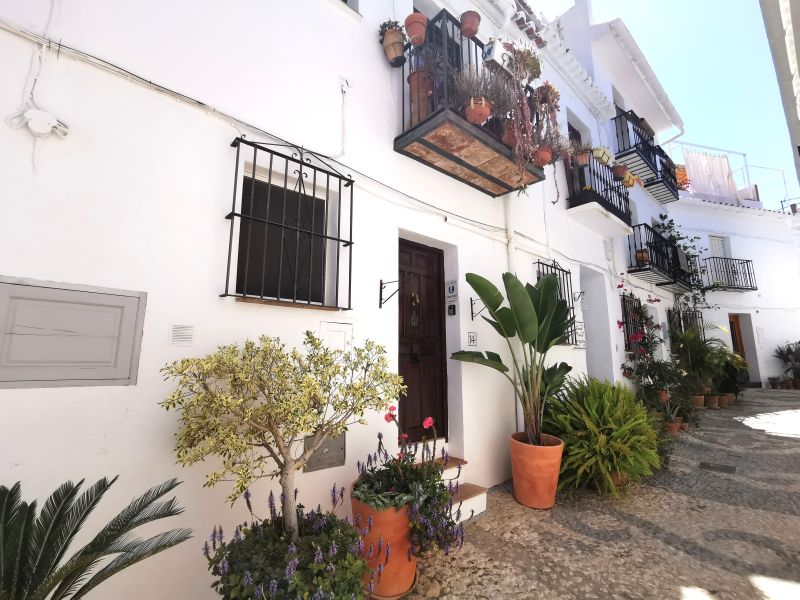

Vélez-Málaga
On a hot sunny afternoon, we negotiated the narrow streets above the shopping district of Vélez-Málaga to visit the San Cristobal Mountain, where the celebrated chapel of ‘Our Lady of the Remedies’ (Ermita de la Virgen de los Remedios) is situated. We secured a park in the small and busy parking lot. It transpired that it was a celebration day, so there were crowds of people in their best Sunday clothes with well-dressed children at hand. We sat in the back row of the church and realised we were there for the full catholic mass before the congregation offered flowers as they walked around the statue of the Virgen, hoping and asking for miraculous remedies for all sorts of ailments, illnesses, and problems; and on this special day, the children get a special blessing from the diety.
The statue is an intricate, stunningly beautiful altarpiece surrounded by baskets of flowers lovingly tended by the women of the congregation. It fits the Baroque architectural style of this historically important pilgrimage site, whose building began in the 1600s, was completed in 1622, and was blessed in 1649. Painted on the interior, murals of the surrounding countryside were completed in the 20th century.
The vast tiled chapel grounds are surrounded by sloping gardens that fall away to the houses and shops all around. Many other churches and convents can be seen from this vantage point above the city.
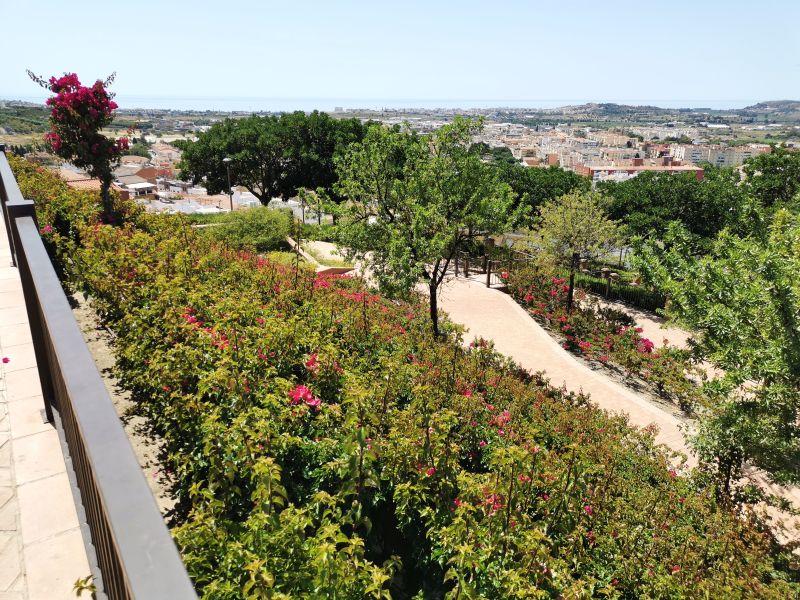
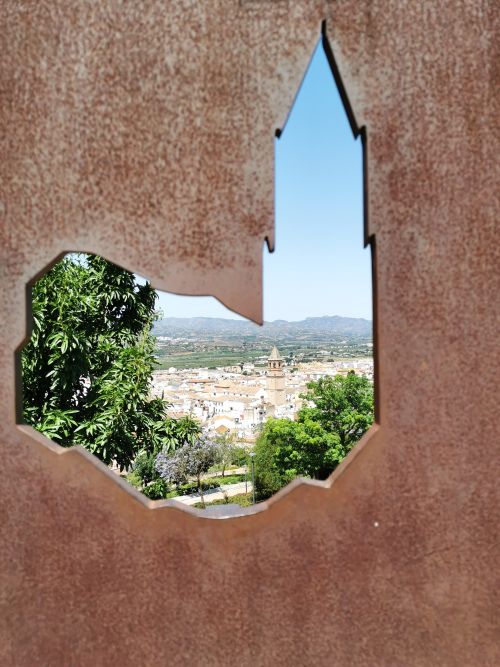
The garden at ‘Our Lady of the Remedies’ and a sculpture in the grounds of ‘Our Lady of the Remedies’
Across the northern valley packed with houses is the impressive ‘Fortress of Velez-Malaga’ or ‘Fortaleza de Vélez-Málaga’, built in the 10th century. This iconic fort is a monument that can be seen from all around the city and was originally built to subdue the Andalucian locals who were making trouble for the Moorish rulers.
According to the website ‘Mi Velez-Malaga’, over the following 500 years, when the population considered themselves Moorish, the fort was viewed as a sign of protection, not oppression. After falling into disrepair in the 19th century, when forts such as this were no longer needed, reconstruction began in the early 21st century and completed in 2013.
You can read more history about the fort and this area at the website below.
Back in the car park, our car was ‘boxed in’, but with some smooth manoeuvring and a driver moving his car, we managed to extricate ourselves from the tight squeeze. However, once out on the narrow road, I managed to create a traffic jam with several people all trying to tell me which way to go! Once I got my eyes fixed on one guy who seemed to know what he was talking about, I followed his instructions and we cleared the narrow lanes of the mountain… next stop Cruza La Calle for a much-needed cold drink!!
Comares
Comares sits on top of a hill inland from La Crujía; and from a distance, the white village looks like snow hanging across the tops. We had previously visited and stayed in this village, and love the views across the fruit and almond orchards and olive groves of the Vélez Valley to the ocean and the Sierra de Tejeda across the valley. Sitting at 703m (2,306.5ft), Comares, meaning ‘castle in the height’, was not founded by the Arabs as so many other towns in the area, but by the Greeks and Phoenicians in the 7th century AD. It became a Moorish Fortress in the 8th century AD and was used as a ‘watchtower’, although it still has the appearance of a fortress. We ventured into the hotel we loved to stay at in the past, and ate a delicious lunch on the terrace with views we had never forgotten.
Please check a previous post here:
https://hotel-rural-verde-oliva.es-andalucia.com
Remember to open up the groups of photos to see them fully!


The patio and view to the Mediterranean from Comares
Karma Guen & Benalmadena
Our Buddhist retreat got underway, and we revelled in the familiar teachings. One important pilgrimage is the steep walk up from the village of Karma Guen to the stupa high on the hill above, which can be seen from many vantage points around the region.
Remember to open up the groups of photos to see them fully!

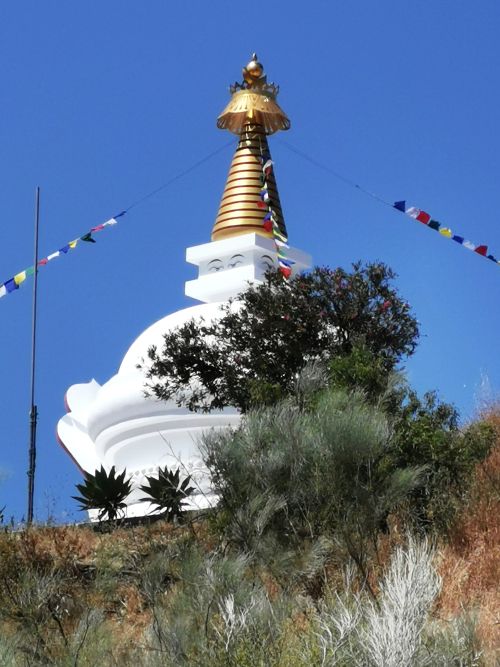

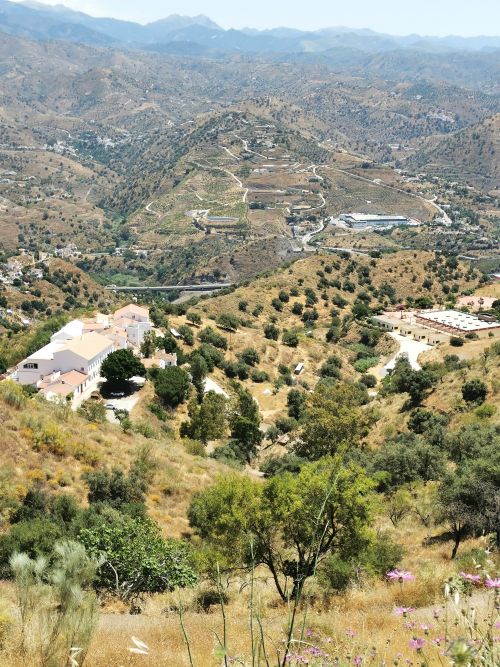
The walk up the hill from Karma Guen Village and Gompa (below) to the stupa on the hill & the view from the top
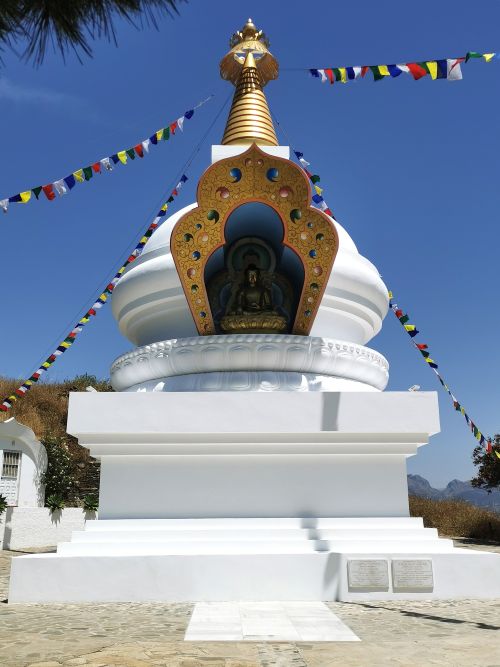
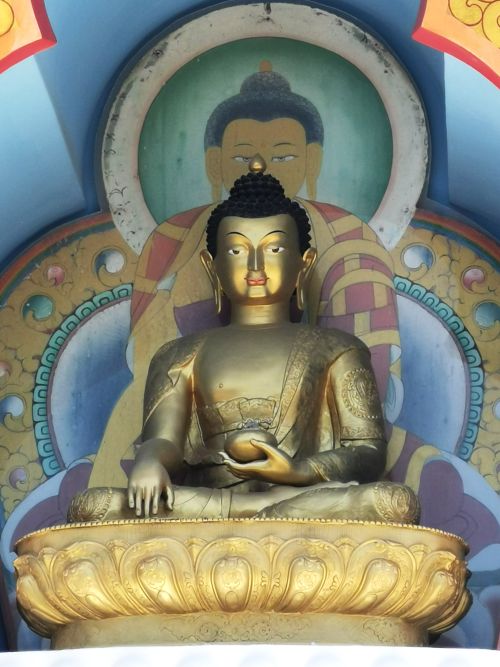
The stupa and the Buddha statue set into the stupa
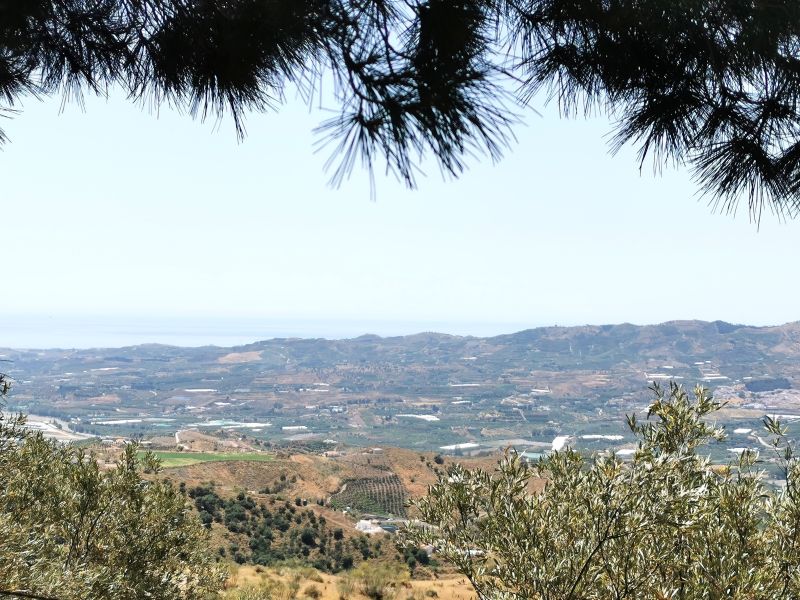
It was lovely to chat with new and old friends, some of whom have lived in New Zealand.
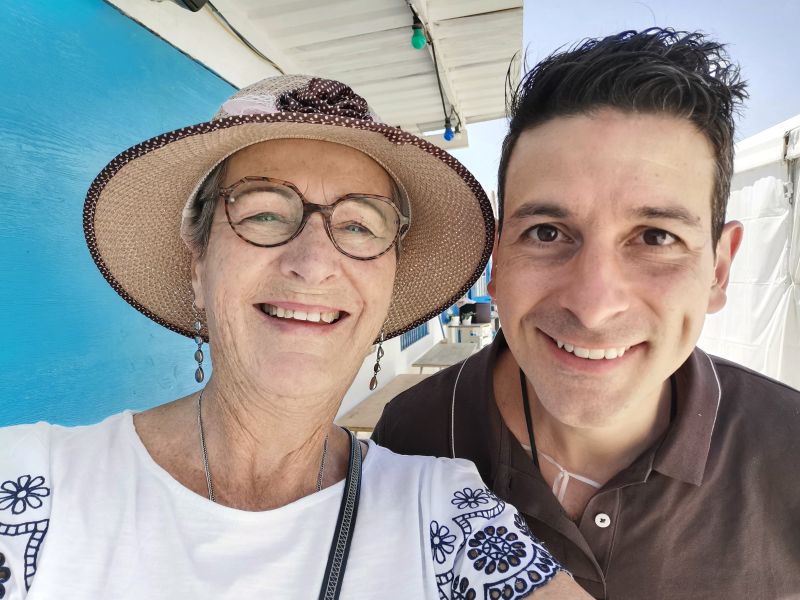
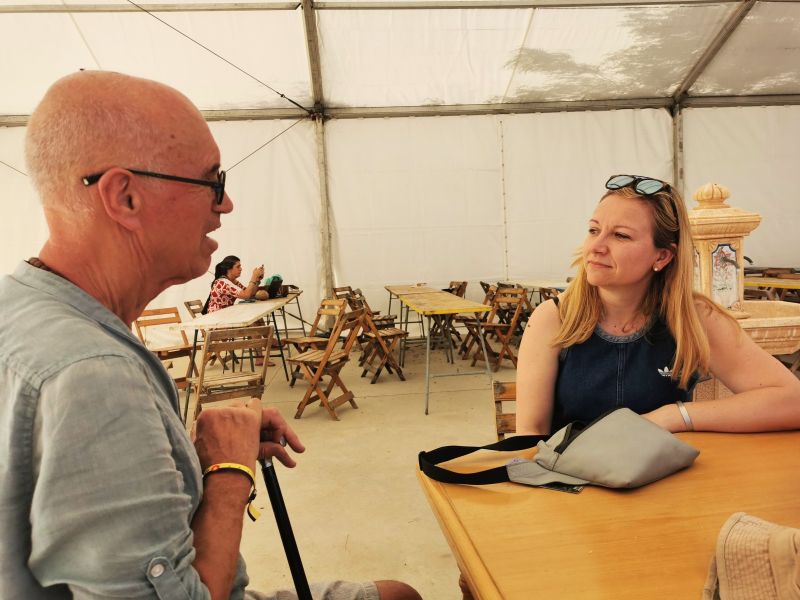
Teresa and Gian-Piero at Karma Guen & Manfred and Hana chatting in the dining tent
One day, while driving back down the hill, a very long, thin green snake slithered across the dusty road and up into the dry grass and rocks and was gone. We did stop and look to see it again, but it was very fast and nowhere to be seen!
Scenes from the Karma Guen gompa and teaching sessions
Remember to open up the groups of photos to see them fully!
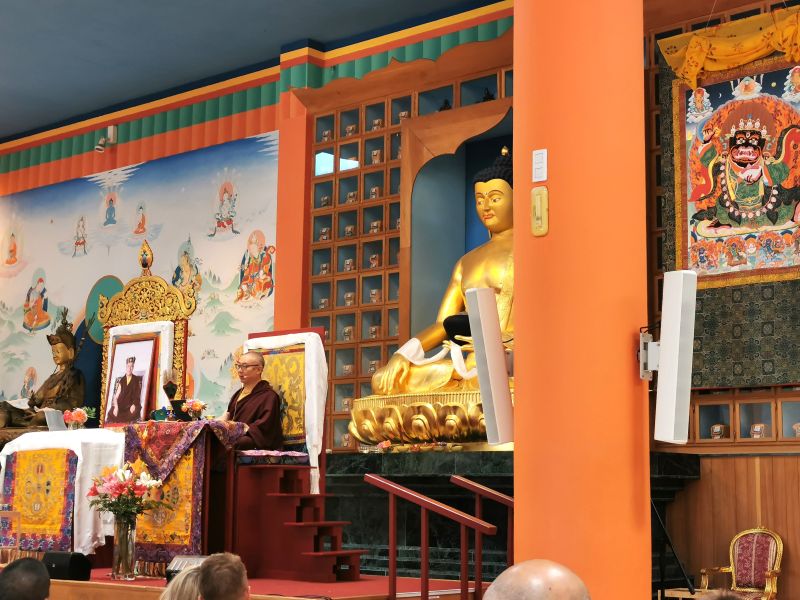
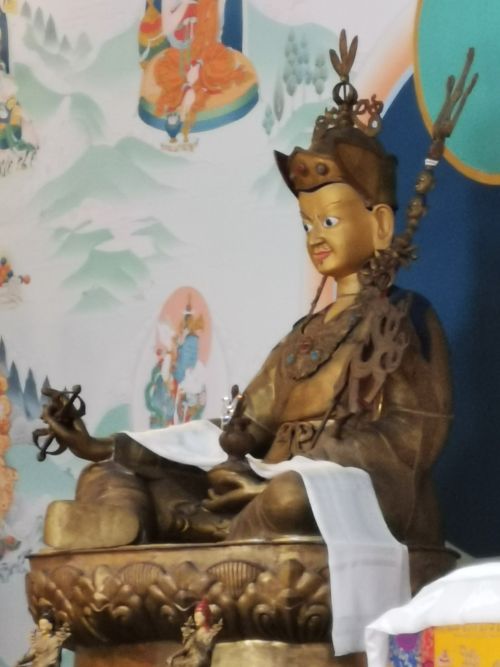

Benalmádena
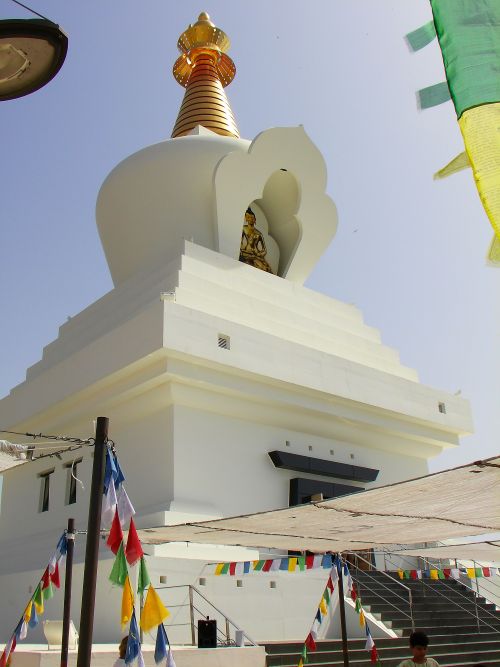
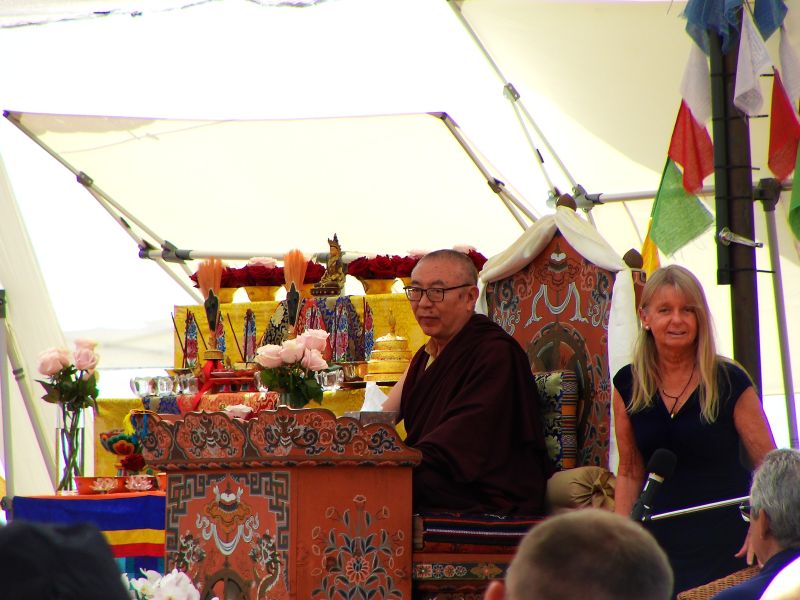
Our last day saw us visiting Benalmadena stupa on the coast east of Málaga, and we enjoyed the special blessings of the teacher who had travelled from Nepal to conduct this retreat.
A day off and a visit to Cómpeta in the mountains
Meanwhile on a ‘day off’ we took the long road up the mountain opposite Karma Guen and drove through familiar territory trying to avoid driving the narrow lanes in the heart of the white villages. That said, sometimes one takes a wrong turn and unwittingly we ended up in the centre of the village and then had to negotiate our way out, which was a bit hair-raising!! We passed through Canillas de Aceituno and by Sedella, Salares, Canillas de Albaida (another favourite village), and on towards Cómpeta.
Remember to open up the groups of photos to see them fully!

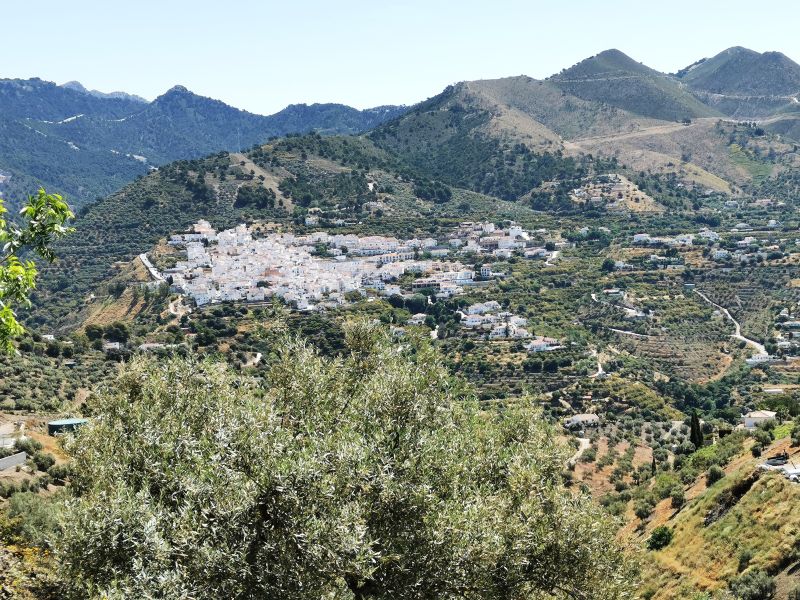

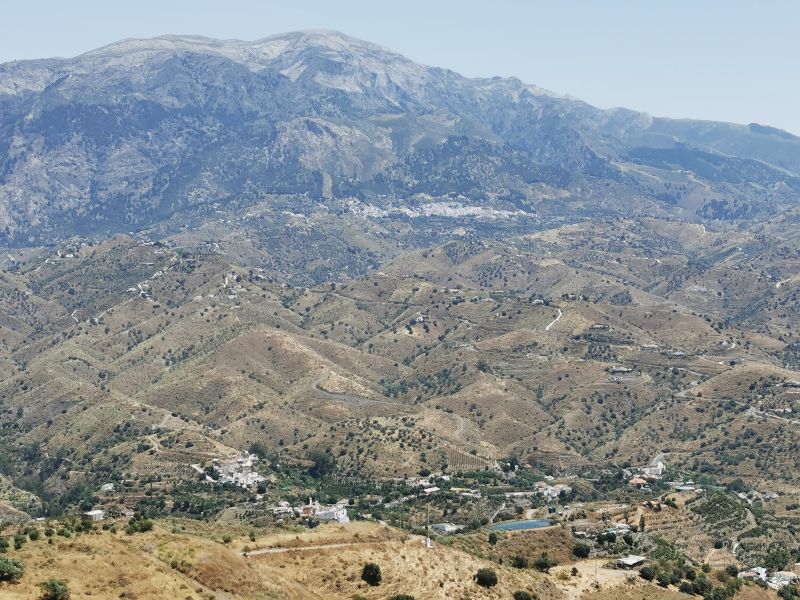
Cómpeta & Canillas de Albaida (top 3) & La Maroma, The Sierra de Tejeda Mountains, Canillas de Aceituno and the valley between as seen from Karma Guen
We passed yet more olive and mango groves and the lovely wineries making the local Moscatel wines from the Muscat grape variety. The dried grapes create ripe, plump raisins which create a taste so rich and juicy coming from the Muscat grape that ends up in the bottle as exquisite tasting wine, warm, thick, and syrupy tasting, just like the raisins!

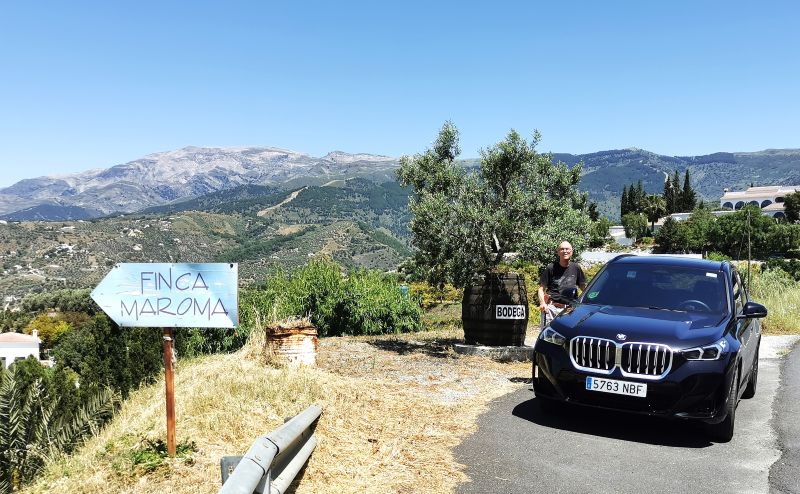
We wandered the tranquil atmospheric streets of Cómpetas past the church (Parroquia Nuestra Señora de la Asunción) in the main square that has beautiful tiles mosaics along the side and up a lane that led us to ‘Tienda De Vinos Almijara’ (wine shop) which we had visited several years before. We spent quite a bit of time tasting, chatting to the lady in the shop, and purchasing some of the specialised Muscatel wine from the region. We had been to the Bodegas Almijara in the past (the winery), but on this occasion it was closed.
Remember to open up the groups of photos to see them fully!
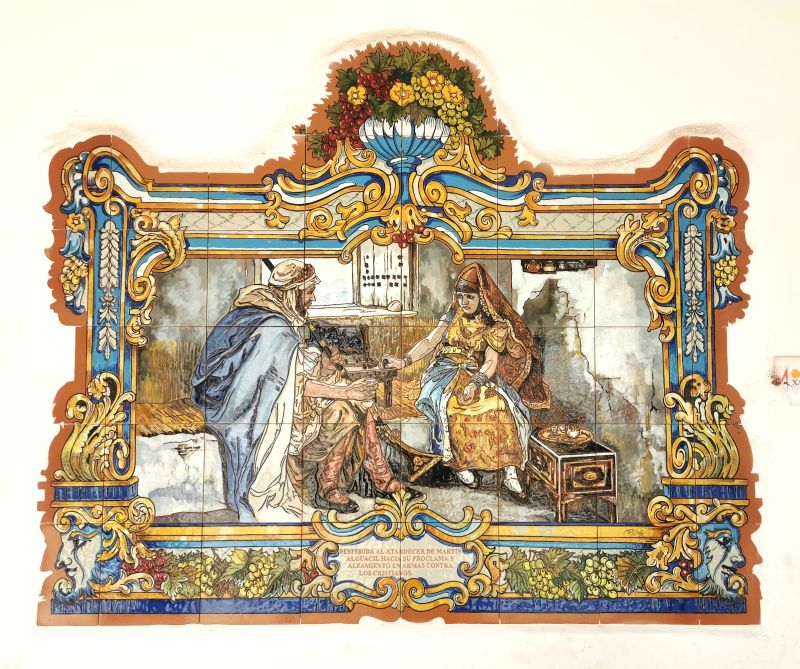

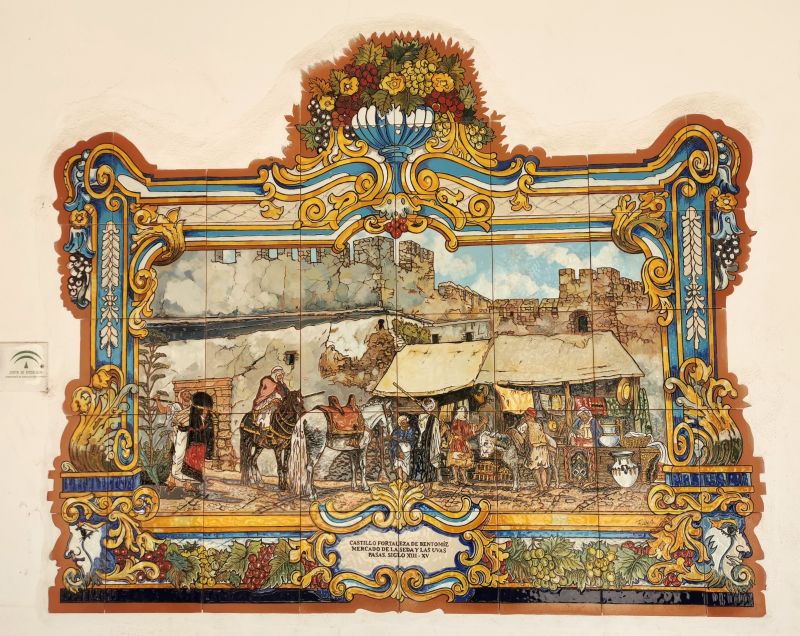

The courtyard of the church in the square in Competa
https://www.bodegasalmijara.com/tienda-en-competa/
Time to move!
We totally loved our accommodation in Escuela with Koen, Lisebeth, and family but, due to the popularity of the ‘old school house’, we needed to move accommodation to complete our time in this area of Axarquía, Andalusia.
Casa Bambu
We moved to the hills on the opposite side of the Valley near Iznate to have a short stay in ‘Casa Bambu’, with an equally amazing view, swimming pool, and accommodation. The time here was restful, allowing for long, enjoyable moments just sitting in our favourite dinner spot, gazing at the sunset as it dipped over the hills that were almost beyond our gaze. On the way back from our day at Benalmádena stupa, we took a different road from the main highway and wound our way high into the hills above the coast through olive groves and the town of Cajiz and down into Iznate, which sits across a small valley from Casa Bambu.
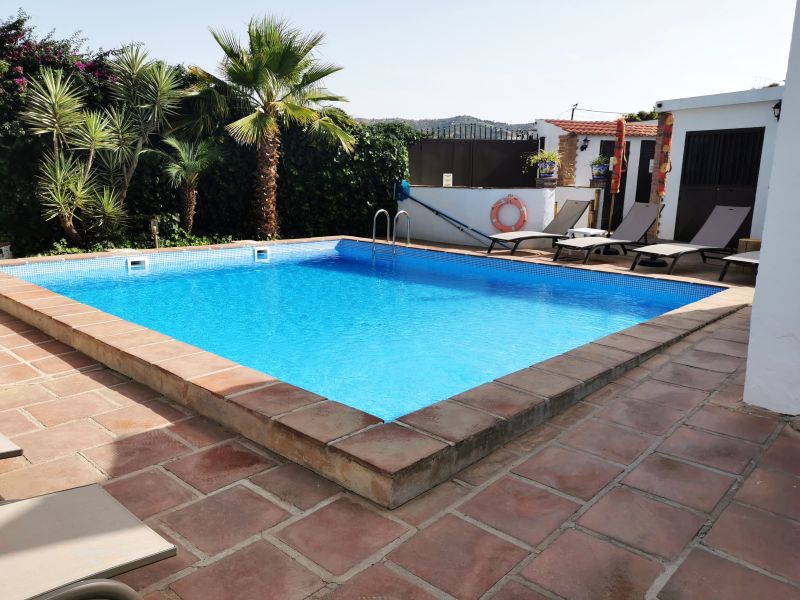
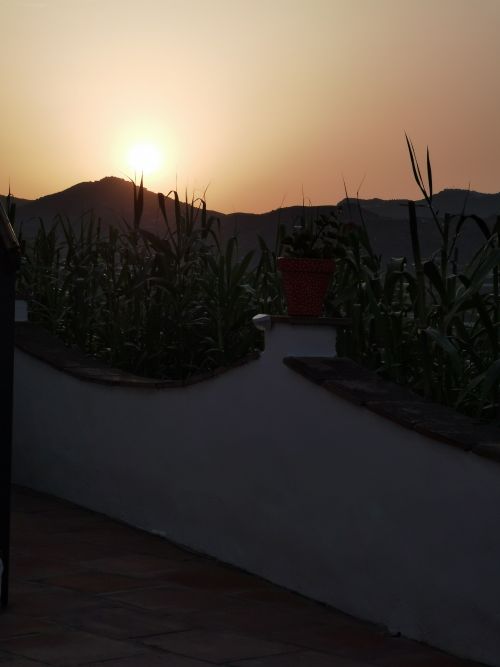
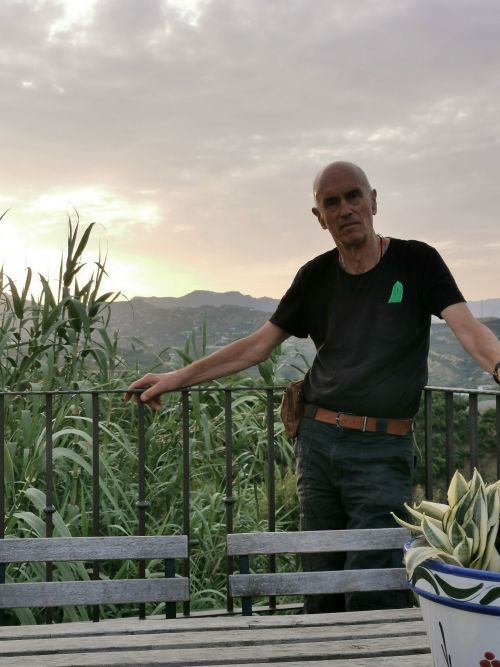
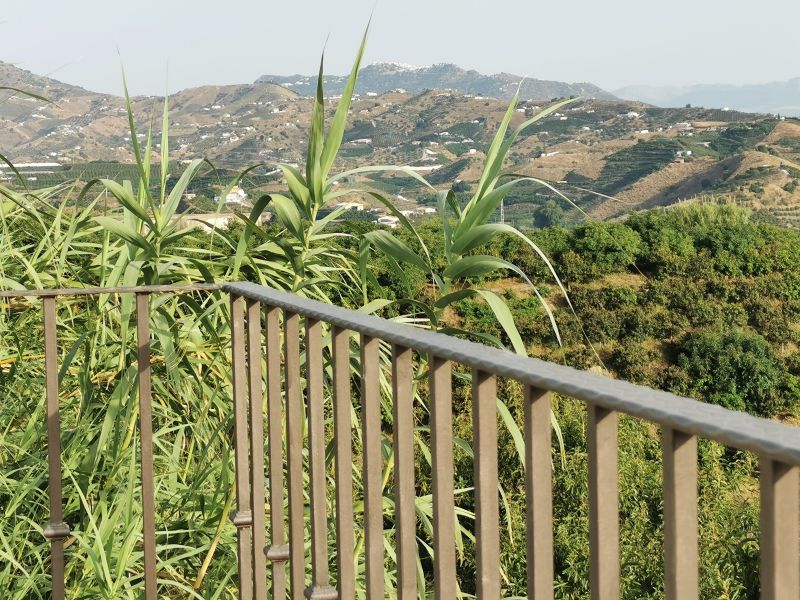
Comares in the far distance as seen from Casa Bambu
These towns are steeped in the history of olive growing, pressing for oil, soap making, flamenco, good food and family. Oh, and the goat cheese is amazing! We even managed to get stuck in a ‘goat jam’ (traffic jam of goats) on our way to Benalmádena—a source of great amusement!
https://www.booking.com/hotel/es/casa-bambu-resort.en-gb.html
Remember to open up the groups of photos to see them fully!
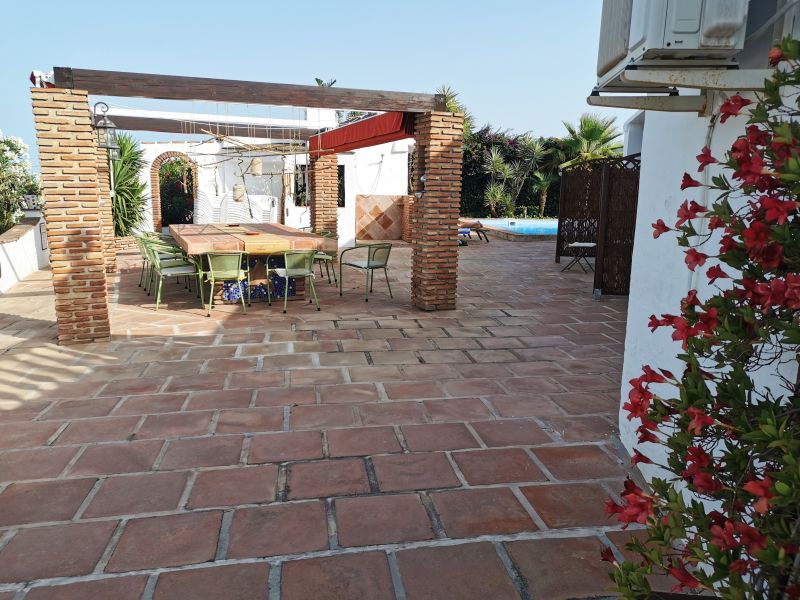
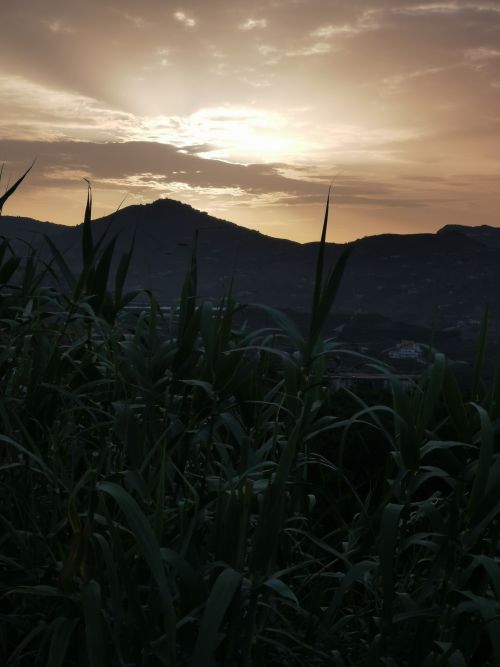

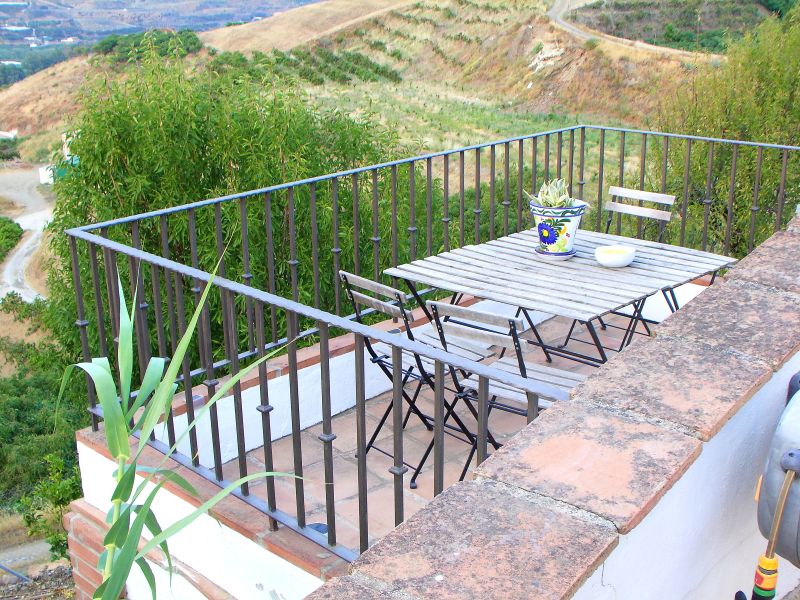
Our favourte hang out spot at Casa Bambu
The door is always open for our return – but in the meantime!
Soon it was time to start the next part of our journey that would take us deep into the national park of Grazalema, west of Málaga. We visited this region of Andalucía in 2008 and were excited to be returning to see places we had stayed and explored, this time staying longer and exploring further. We discussed the route to take, finding out a landslide had closed one road, and finally settled on the coastal highway, breaking off at Marbella and driving inland. Watch out for the next instalment of this Spanish Soujourn where experiences vary from country to town, to high passes and river cruises in Seville, and more wine and good food!


